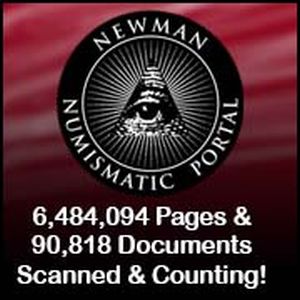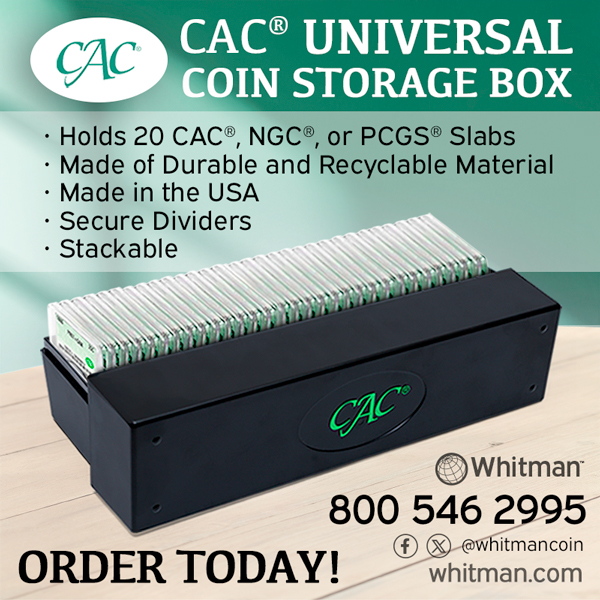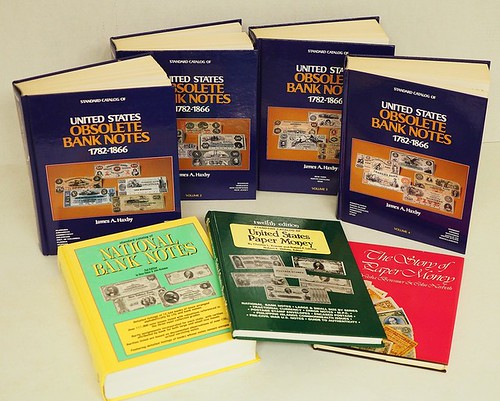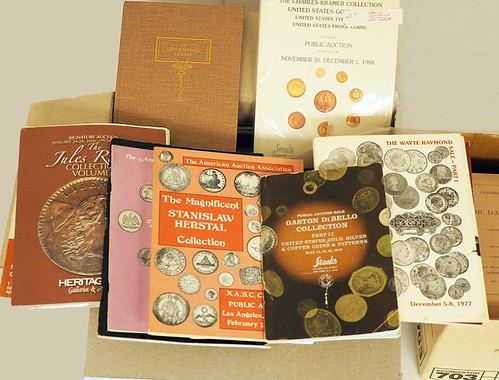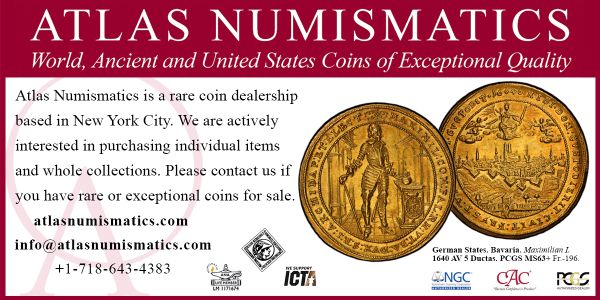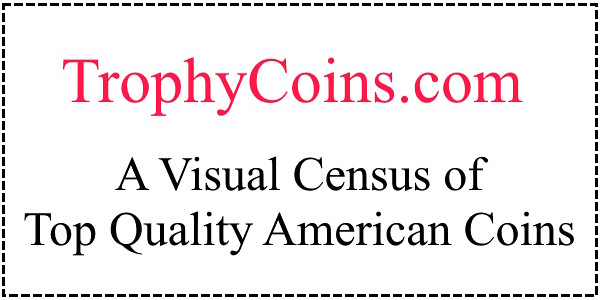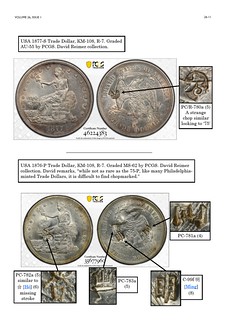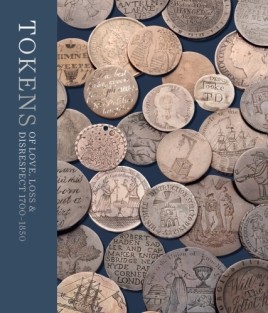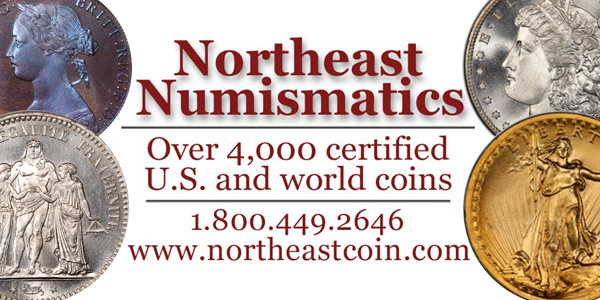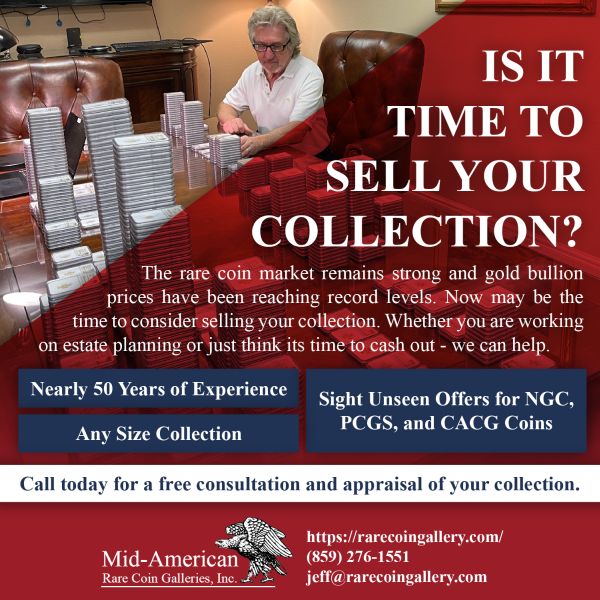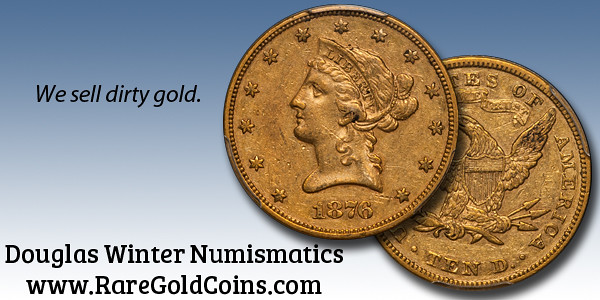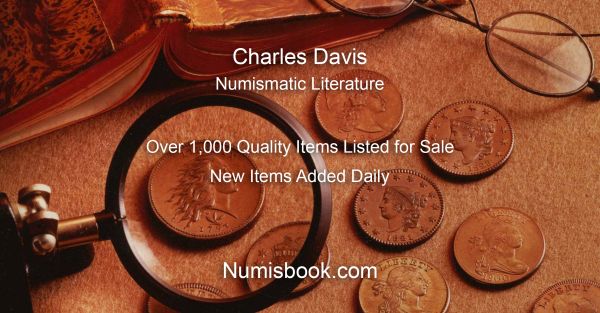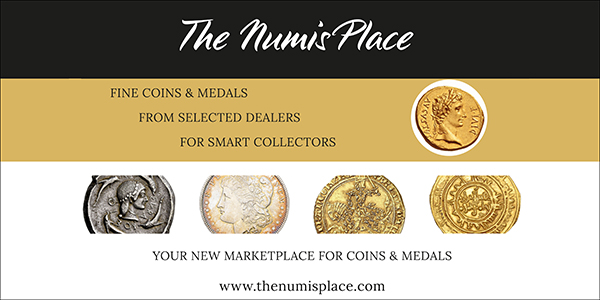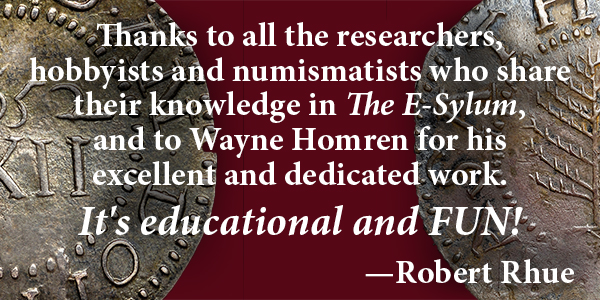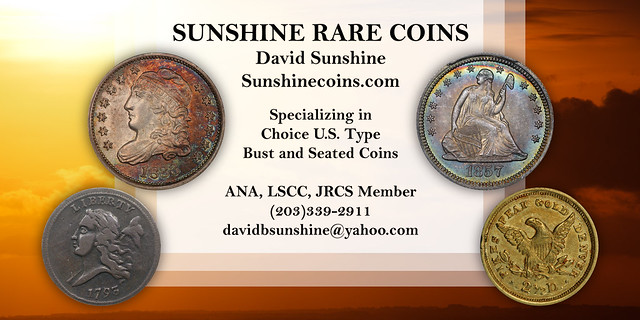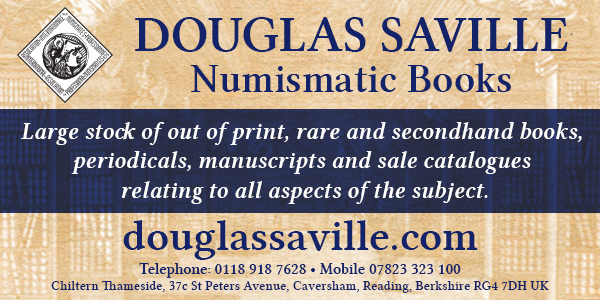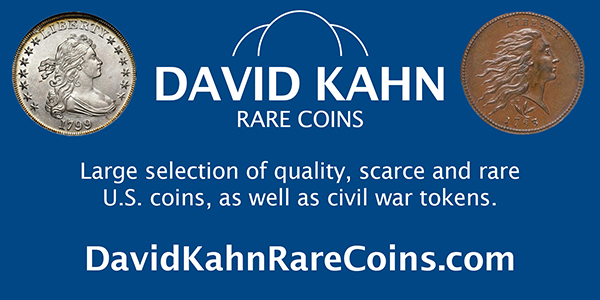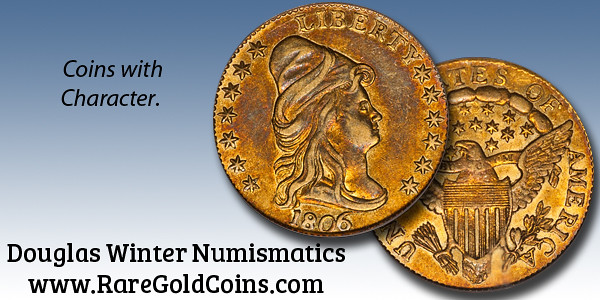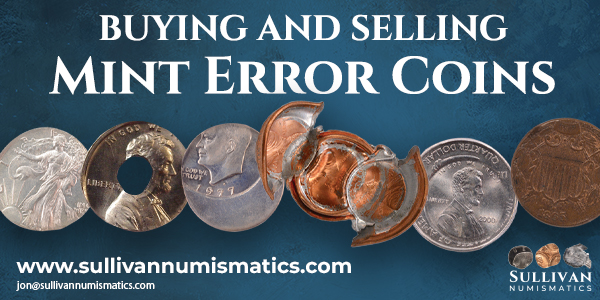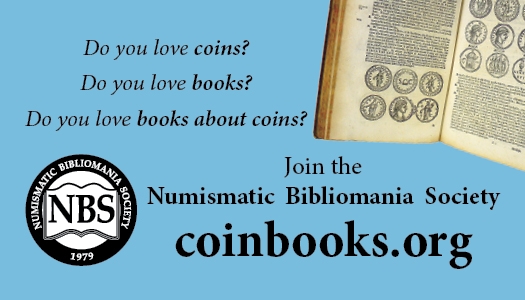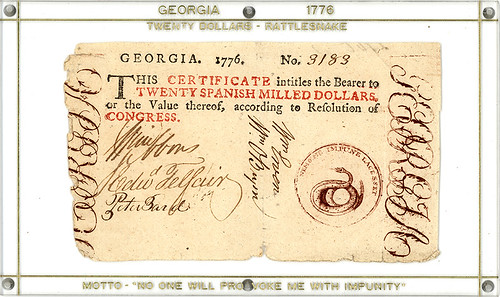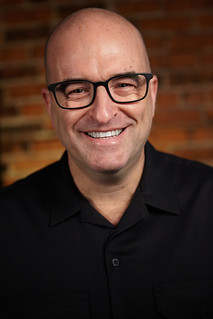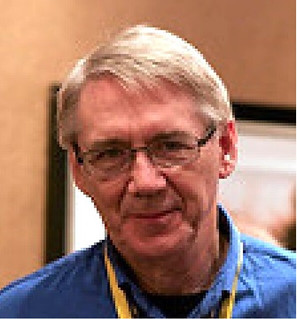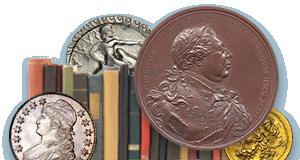
Visit our NBS Sponsors
About UsThe Numismatic Bibliomania Society is a non-profit association devoted to the study and enjoyment of numismatic literature. For more information please see our web site at coinbooks.org SubscriptionsThose wishing to become new E-Sylum subscribers (or wishing to Unsubscribe) can go to the following web page link MembershipThere is a membership application available on the web site Membership Application To join, print the application and return it with your check to the address printed on the application. Print/Digital membership is $40 to addresses in the U.S., and $60 elsewhere. A digital-only membership is available for $25. For those without web access, write to: Jeff Dickerson, Treasurer AsylumFor Asylum mailing address changes and other membership questions, contact Jeff at this email address: treasurer@coinbooks.org SubmissionsTo submit items for publication in The E-Sylum, write to the Editor at this address: whomren@gmail.com BUY THE BOOK BEFORE THE COINSale CalendarWatch here for updates! |
- WAYNE'S WORDS: THE E-SYLUM FEBRUARY 16, 2025
- ASYLUM SPRING 2025 ISSUE PUBLISHED
- NUMISMATIC AUCTIONS SALE 69 LITERATURE LOTS
- NEW BOOK: GOLD BARS OF THE CENTRAL MINTS
- PERIODICAL: OCCASIONAL NUMISMATIC PAPERS NO. 3
- PERIODICAL: ASIAN NUMISMATICS NO. 52
- PERIODICAL: CHOPMARK NEWS FEBRUARY 2025
- GARY ODDIE (1965-2025)
- A PRESIDENT'S DAY MEDAL MYSTERY
- VIDEO: IOWA COMMEMORATIVE HALF DOLLARS
- HR 595: LAWFUL TRADE IN COLLECTORS' COINS
- TAMS AND BRASS CHECKS AND RED LIGHTS
- THE COIN-DITION CHECK LIST
- ON VICTOR DAVID BRENNER'S NAME
- SAN FRANCISCO SAFE DEPOSIT BOX ERROR HOARD
- NOTES FROM E-SYLUM READERS: FEBRUARY 16, 2025
- COINAGE OF THE PHILIPPINES ANA TALK
- VOCABULARY TERMS: REGARDANT, REGISTER
- H. G. BROWN (1852-1911)
- 1871 CARSON CITY MINT DOCUMENTS
- JACOB LIPSON SELECTIONS: FEBRUARY 16, 2025
- MORE NUMISMATIC AUCTIONS SALE 69 SELECTIONS
- DAVISSONS AUCTION 44 ANNOUNCED
- KUENKER AUCTION SALE 419
- ANCIENT ROMAN COIN STUCK BETWEEN ROCKS
- HOLEY DOLLAR RETURNED TO POLAND
- PRIVY MARKS ON COINS
- THE 2025 TRIAL OF THE PYX
- THE PENNY PURGE: COMMON CENTS OR CENTSLESS?
- BULK COIN MELT-VALUE SPECULATION
- COLONIAL GEORGIA COLORED SEALS, PART 2
- ASCENDING AND DESCENDING PAIRS
- NUMISMATIC ART IN NEW YORK
- THE COSTS OF COLLECTING
- ABOUT THIS ISSUE: FEBRUARY 16, 2025
Content presented in The E-Sylum is not necessarily researched or independently fact-checked, and views expressed do not necessarily represent those of the Numismatic Bibliomania Society.
WAYNE'S WORDS: THE E-SYLUM FEBRUARY 16, 2025
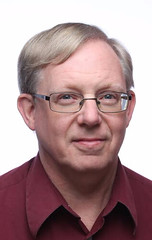 New subscribers this week include:
Michel Vonk, courtesy Adrian J. Lansen; and
Jerry Jordan, courtesy Mel Wacks.
Welcome aboard! We now have 7,254 subscribers.
New subscribers this week include:
Michel Vonk, courtesy Adrian J. Lansen; and
Jerry Jordan, courtesy Mel Wacks.
Welcome aboard! We now have 7,254 subscribers.
Thank you for reading The E-Sylum. If you enjoy it, please send me the email addresses of friends you think may enjoy it as well and I'll send them a subscription. Contact me at whomren@gmail.com anytime regarding your subscription, or questions, comments or suggestions about our content.
This week we open with a new issue of The Asylum, a numismatic literature sale, one new book, three periodicals, an obituary, updates from the Newman Numismatic Portal, and more.
Other topics this week include Asian numismatics, chopmarks, a rare President's Day medal, Iowa commemorative halves, the Token and Medal Society, Victor David Brenner, coins of the Philippines, the Carson City Mint, fixed price and auction selections, a holey dollar, the Trial of the Pyx, the penny purge, numismatic art, and the hidden costs of collecting.
To learn more about Charles I. Bushnell, The Voice of the Turtle, gold bars issued in China and Taiwan in 1945-50, Gary Oddie, the Coin-Dition Check List, 1804 dollar owner H. G. Brown, the Canada Subdued medal, Celtic rarities, Dolphin money, privy marks, and coin melt-value speculation, read on. Have a great week, everyone!
Wayne Homren
Editor, The E-Sylum
ASYLUM SPRING 2025 ISSUE PUBLISHED
The Spring 2025 issue of The Asylum is on the way from our sponsor, the Numismatic Bibliomania Society. Maria Fanning edits our print journal, and she submitted this report. Thank you. -Garrett
Welcome to The Asylum's Spring 2025 digital edition.
- Charles I. Bushnell: Attorney and Counsellor at Law By Julia Casey
- The Voice of the Turtle and the Ancient Coin Club of America: Rediscovering a Lost Chapter in Numismatic Literature By William E. Daehn
- The Secret Service and the Secret M. A. Brown Plates By Leonard Augsburger
- The Bibliographical Society Medal By Ira Rezak
- An Unusual Wedding Present "Full of New Ideas and Possibilities" By David Pickup
- A Bibliography of Inaugural Medal Reference Works By Michael B. Costanzo
Message from NBS President Len Augsburger
Books are where you find them, and while we have several established numismatic booksellers ably serving the hobby, there are yet other venues available to the determined book hunters among us. Just today I learned about a copy of Jacob Perkins' Bank Bill Test, one of the famed rarities of American numismatic literature, which appeared on eBay in 2010 (more about this in a future article).
Apart from online sources such as eBay, Abebooks, Bookfinder, etc., collectors can explore retail outlets including secondhand bookstores and book fairs. One of the best-known shows is the New York International Antiquarian Book Fair, which this year takes place from April 3 to April 6 at the Park Avenue Armory in New York City.
Related to this event is the video The Booksellers (2019), available on streaming services including Prime Video. A careful viewing of this video will reveal at least one prominent New York numismatist in attendance at the International Antiquarian Book Fair. Moreover, the video delivers an insightful view of our quirky corner of the world and is highly recommended.
Regardless of where you acquire your books, I hope this new year brings interesting additions to your library. While five-figure rarities like the Perkins Bank Bill Test are highly prized for a reason, one need not spend large amounts to acquire items that tell compelling stories about numismatic objects and the people who collect them. Here's hoping that these stories in your library abound in the coming months.
NBS Membership Renewal Time!
 Please renew your membership in the NBS to continue receiving The Asylum. Go to coinbooks.org to pay by PayPal or download a membership form today. Your current expiration date is printed to the right of your name on your subscription envelope, which should be arriving soon.
Please renew your membership in the NBS to continue receiving The Asylum. Go to coinbooks.org to pay by PayPal or download a membership form today. Your current expiration date is printed to the right of your name on your subscription envelope, which should be arriving soon.
NUMISMATIC AUCTIONS SALE 69 LITERATURE LOTS
Steve Davis of Numismatic Auctions LLC is holding Sale 69 this month. Here are some selected lots of numismatic literature from the Myron Xenos Money Tree library. These are all bulk lots of multiple titles, excellent for those building up a library of their own. -Editor
US Specialized Gold Coinage Numismatic Literature Box Lot of Varied References - All Different Hardbound Examples 15 Volumes Ex Money Tree Archives. Features some classic, other modern and iconic references, all different and all hardbound types including a full seven volume set of Akers, other titles written by and with content from Adams, Barfield, Dannreuther, Kagin, Bowers, Loewinger, Winters and others including specialized references on Bechtler, California Gold, Charlotte and Dahlonega Mint Coinage(2), Proof & Die Variety/Die State works on US Gold Coinage, even a scarce Charles Kramer Collection Hardbound Auction Catalog and more!
To read the complete lot description, see:
US Specialized Gold Coinage Numismatic Literature Box Lot of 15
(https://numismaticauctions.nextlot.com/auctions/1704961/lots/38264192)
US Classic & Standard References Numismatic Literature Box Lot of 17 Volumes - Mostly Hardbound. Features such authors as Sheldon, Gilbert, Browning, Beistle, Overton, Judd, Breen, Swiatek, Pollack, Taxay, Valentine and more, a couple duplicates or multiple editions present. Nice condition overall and a great opportunity to obtain some US Classic titles and works. Pleasing condition throughout, light use and well cared for.
To read the complete lot description, see:
US Classic & Standard Named Reference Works 17 Volume Numismatic Literature Box Lot
(https://numismaticauctions.nextlot.com/auctions/1704961/lots/38264206)
Ancient & Medieval References, Topicals & More Numismatic Literature Box Lot. Features approximately 17 HB and 11 SB works and specialized issues and vintage volumes. From the Money Tree Archives of Myron Xenos, remainders of his Numismatic Literature Auction House once operating in Rocky River, Ohio.
To read the complete lot description, see:
Ancient & Medieval References, Topicals & More Numismatic Literature Box Lot
(https://numismaticauctions.nextlot.com/auctions/1704961/lots/38264241)
Excellent US Obsolete & National Currency Hardbound Numismatic Literature Box Lot features a full Four Volume complete set of Haxby HB issues on Obsolte Banknotes by State, the Hickman-Oakes National Banknotes reference and many others. From the Money Tree Archives of Myron Xenos, remainders of his Numismatic Literature Auction House once operating in Rocky River, Ohio.
To read the complete lot description, see:
Excellent US Obsolete & National Currency Hardbound Numismatic Literature Box Lot
(https://numismaticauctions.nextlot.com/auctions/1704961/lots/38264255)
Spain, Mexico & Latin American Related Reference Works Numismatic Literature Box Lot. Featuring 15 HB and 4 SB editions including the sought after works Resplandores, Hookneck, several specialty volumes on 8 Ocho Reales, Atocha/Shipwreck recovery, Cob Coinage and much more! From the Money Tree Archives of Myron Xenos, remainders of his Numismatic Literature Auction House once operating in Rocky River, Ohio.
To read the complete lot description, see:
Spain, Mexico & Latin American Related Reference Works Numismatic Literature Box Lot
(https://numismaticauctions.nextlot.com/auctions/1704961/lots/38264262)
Specialized English, Chinese, Far East & Russia Numismatic Literature Box Lot, couple better titles and large reference works. From the Money Tree Archives of Myron Xenos, remainders of his Numismatic Literature Auction House once operating in Rocky River, Ohio.
To read the complete lot description, see:
Specialized English, Chinese, Far East & Russia Numismatic Literature Box
(https://numismaticauctions.nextlot.com/auctions/1704961/lots/38264290)
Miscellaneous European Specialized Numismatic Literature Box Lot with some better titles on Multiple Talers and more, a couple duplicates. From the Money Tree Archives of Myron Xenos, remainders of his Numismatic Literature Auction House once operating in Rocky River, Ohio.
To read the complete lot description, see:
Miscellaneous European Specialized Numismatic Literature Box Lot
(https://numismaticauctions.nextlot.com/auctions/1704961/lots/38264297)
The Ultimate Davenport Crowns & Talers to Silver Gulden Reference Collection Numismatic Literature Box Lot featuring 16 different Volumes and/or editions, including a couple of the rarer variants and one may even find an autographed edition in the group if the fates allow. A fantastic and virtually complete collection of Davenport references is a standard and sought after element of any Taler specialist or World Crown maven and aficiando's library of reference works. From the Money Tree Archives of Myron Xenos, remainders of his Numismatic Literature Auction House once operating in Rocky River, Ohio.
To read the complete lot description, see:
The Ultimate Davenport Crowns & Talers to Silver Gulden Reference Collection Numismatic Literature Box
(https://numismaticauctions.nextlot.com/auctions/1704961/lots/38264318)
Huge Antiquarian Library Auctions bankers box of 19th to 20th century catalogs to Modern, Named & Better HB/SB Rare Coin Auction Catalogs Numismatic Literature Double Box Lot. From the Money Tree Archives of Myron Xenos, remainders of his Numismatic Literature Auction House once operating in Rocky River, Ohio.
To read the complete lot description, see:
Huge Antiquarian Library Auctions to Modern, Named & Better Coin HB/SB Auction Catalogs Numismatic Literature
(https://numismaticauctions.nextlot.com/auctions/1704961/lots/38264346)
For more information, or to bid, see:
https://numismaticauctions.nextlot.com/auctions/
To read the earlier E-Sylum articles, see:
NUMISMATIC AUCTIONS LLC SALE 69
(https://www.coinbooks.org/v28/esylum_v28n05a23.html)
MORE ON NUMISMATIC AUCTIONS LLC SALE 69
(https://www.coinbooks.org/v28/esylum_v28n06a20.html)
NEW BOOK: GOLD BARS OF THE CENTRAL MINTS
Colin Gullberg passed along this announcement of his friend Stephen Tai's new book on China/Taiwan gold in the 1945-50 period. Thank you. -Editor
 The Gold Bars of the Central Mints 1945-1950
The Gold Bars of the Central Mints 1945-1950
By: Stephen Tai
A new book has recently been released by author Stephen Tai. This is his 14th book and is the first book in English to cover the history of the gold bars issued in China and Taiwan in 1945-50, the period of the end of the Chinese Civil War and the Republican retreat to Taiwan.
Mr. Tai is the first author to have used recently declassified government documents held in the Taiwan government archives. The book starts with a brief overview of the end of Chinese taels and the silver standard and the introduction of fiat currency. This is quickly followed by the casting of gold bars in China followed by the issuance of gold bars in Taiwan in 1949 following the end of the civil war.
The book covers the history of the minting of the gold bars in various Chinese mints in addition to foreign bars in circulation at the time. Of particular importance is the numbering system used when stamping the ingots as well as production figures. The book ends with detailed recent auction records.
The Gold Bars of the Central Mints is a landmark work and is destined to become the authority work on the subject. It is a work anyone interested in gold, Chinese numismatics or Chinese financial history should own.
Title: The Gold Bars of the Central Mints
Author: Stephen Tai
Price: US$75 [this includes $25 S&H worldwide]
[Payment by PayPal or Wise]
Pages: 205
ISBN: 978-0-9905200-6-1
Issued: Nov 2024
Publisher: iAsure Group
To order please email: chopmarknews@gmail.com
PERIODICAL: OCCASIONAL NUMISMATIC PAPERS NO. 3
Christopher Faulkner and Jacob Lipson edit Occasional Numismatic Papers, an online publication devoted to original Canadian numismatic research. The latest number is now available. -Editor
CONTENTS
- About the Contributors
- Letters to the Editors
- Wood 23 Error: Double Flip Strike by Ray Malone
- Research Notes and Queries
- The P.E.I. Penny: The Case for Dennis McCarthy by Edward Banning and Christopher Faulkner
- Archives, Museums, Libraries: Glenbow Institute
- A Red River Bank by Warren Baker
- Documents, Artifacts, Photographs: Notepaper of W.L. Bastien
- Obituaries from Yesteryear: W.L. Bastien
- Contributor Guidelines
To read the complete issue, see:
Occasional Numismatic Papers No. 3
(https://cnr-rnc.ca/wp-content/uploads/2025/02/Occasional-Numismatic-Papers-no.-3-January-2025.pdf)
PERIODICAL: ASIAN NUMISMATICS NO. 52
Here are the contents of the latest issue of Numismatique Asiatique (Asian Numismatics). -Editor
 EDITORIAL
EDITORIAL
Il était grand temps de « déconstruire » la Monnaie de Paris
It was high time to "deconstruct" the Paris Mint
VIETNAM
The Merit Awards of Vietnam
by Craig Greenbaum
LAOS
Les usages monétaires chez les Hmong du Laos (2ème partie)
par Alain Escabasse
INDOCHINE
Contremarques françaises sur des monnaies circulant en Indochine
par José Antonio de la Fuente
Petite série d'essais inédits pour l'Indochine
par Daniel Cariou
Archives / Annam
Les Monnaies de l'Annam (1898) de Léon Boulloche
par Alain Escabasse
Actualité
Vente de quelques monnaies annamites intéressantes
par François Joyaux
Bibliographie
Monnaies d'Asie n° 16 : « Monnaies privées d'Annam »
de François Joyaux
Addenda / Annam
Un Nhị Nghi de Bảo Đại
par Daniel Cariou
68 pages in color. Format A4 (21 x 29 cms).
For more information, or to order, see:
https://sites.google.com/site/societedenumismatiqueasiatique/adhesion
https://sites.google.com/site/societedenumismatiqueasiatique/revue
PERIODICAL: CHOPMARK NEWS FEBRUARY 2025
The latest issue of The Chopmark News has been published by editor Colin Gullberg. It's the official publication of the Chopmark Collectors Club. Here's an excerpt from his From the Editor comments followed by the issue's table of contents. -Editor
 In this issue, we
meet new member
Josh Shaffer. Josh
is a dealer in Ohio
and who, unlike
many dealers, has
an interest in
chopmarked coins.
Welcome to the
club Josh!
In this issue, we
meet new member
Josh Shaffer. Josh
is a dealer in Ohio
and who, unlike
many dealers, has
an interest in
chopmarked coins.
Welcome to the
club Josh!
Another new member, Robert Bracey, has written an article on Indian numismatics entitled "Are there chopmarks on Indian coins?" We haven't published much on Indian coins but shroff marks are a regular feature on Indian hammered coinage. By the way, Robert has taken over Helen Wang's position as head of Asian numismatics at the British Museum.
Dealer-member Scott Semans has sent me some of his old fixed price lists. Scott has handled a lot of chopmarked coins in the past and thought these might be of interest to some readers.
Ben Dalgleish in Hong Kong has sent an article of an interview he did with long-time Hong Kong dealer-collector Henry Chan. Mr. Chan is one of the few Chinese who has developed an interest in chopped coins.
Finally, in The Interview I talk to long-time NYC dealer Paul Bosco, best known in chopmark circles as the dealer who handled the Hal Walls collection. This interview was actually done over a period of many years, first by email and then at his shop in New York city.
Of course, there are pictures from recent Stack's Bowers sales and Taylor Leverage's Reddit page.
CONTENTS
From the Editor
New Members
Meet our Members: Josh Shaffer
Coins from the Josh Shaffer Collection
Coins from Our Members' Collections
Are there chopmarks on Indian coins?
By: Robert Bracey
From the Past—My Fixed Price Lists
By: Scott Semans
From Reddit
By: T. Leverage
Henry Chan: A hidden treasure in Hong Kong
By: Ben Dalgleish
Recent Sales — Stack's Bowers
The Interview — Paul Bosco
For more information, write to:
chopmarknews@gmail.com
GARY ODDIE (1965-2025)
Jeff Rock submitted this remembrance of researcher and author Gary Oddie. Thank you. Sorry to hear this news. -Editor
January 23, 1965 – February 5, 2025
 It is with great sadness that collectors learned of the death of Gary Oddie, managing to just cross the 60-year mark before succumbing after a long, valiant battle with cancer. Gary was well-known in the UK, giving countless talks and writing what seemed like a major article or blog post every week. Gary authored or edited three books on the tokens and such of the two counties he lived in, Bedfordshire and Cambridgeshire. The first, in 2011, was Bedfordshire Seventeenth Century Tokens, by John Gaunt, greatly expanded by Gary, which was an in-depth look at the 100 or so issuers of 17th century tokens in that county, including numerous previously unknown varieties, with much research into the lives of the token issuers, their trades, and the economics of the time which required the issuance of tens of thousands of different tokens across England. This was the first in a series authored by Token Corresponding Society members which re-appraise Williamson's 17th century token reference book, county by county, illustrated with the best examples available and with up to date research.
It is with great sadness that collectors learned of the death of Gary Oddie, managing to just cross the 60-year mark before succumbing after a long, valiant battle with cancer. Gary was well-known in the UK, giving countless talks and writing what seemed like a major article or blog post every week. Gary authored or edited three books on the tokens and such of the two counties he lived in, Bedfordshire and Cambridgeshire. The first, in 2011, was Bedfordshire Seventeenth Century Tokens, by John Gaunt, greatly expanded by Gary, which was an in-depth look at the 100 or so issuers of 17th century tokens in that county, including numerous previously unknown varieties, with much research into the lives of the token issuers, their trades, and the economics of the time which required the issuance of tens of thousands of different tokens across England. This was the first in a series authored by Token Corresponding Society members which re-appraise Williamson's 17th century token reference book, county by county, illustrated with the best examples available and with up to date research.
 Gary then tackled the rest of the token issues for Bedfordshire in his 2023 book Bedfordshire Tokens, Tickets, Checks, and Passes; this included over 400 different pieces from lead tokens of the 15th century through the handful of 18th century Conder token issues of the country, to pieces made in the 20th and 21st centuries. The following year saw the publication of Cambridgeshire Seventeenth Century Tokens, an in-depth look at these issues, again with large amounts of background detail about the issuers. Gary also studiously catalogued the 300+ engraved tokens in the Timothy Millett collection featured in the 2022 book Tokens of Love, Loss and Disrespect 1700-1850, by Sarah Lloyd and Timothy Millett. Gary freely shared information with fellow collectors and researchers, and while he only authored a few books on his own, his research was an integral part of dozens of other books published in the last three decades.
Gary then tackled the rest of the token issues for Bedfordshire in his 2023 book Bedfordshire Tokens, Tickets, Checks, and Passes; this included over 400 different pieces from lead tokens of the 15th century through the handful of 18th century Conder token issues of the country, to pieces made in the 20th and 21st centuries. The following year saw the publication of Cambridgeshire Seventeenth Century Tokens, an in-depth look at these issues, again with large amounts of background detail about the issuers. Gary also studiously catalogued the 300+ engraved tokens in the Timothy Millett collection featured in the 2022 book Tokens of Love, Loss and Disrespect 1700-1850, by Sarah Lloyd and Timothy Millett. Gary freely shared information with fellow collectors and researchers, and while he only authored a few books on his own, his research was an integral part of dozens of other books published in the last three decades.
But it was in shorter form that Gary really found his calling, authoring numerous articles for The Token Corresponding Society Bulletin, The Conder Token Collector's Journal, and a number of other British numismatic publications. But as most of his research was done in the digital age, the bulk of his work was not for print, but for the British Numismatic Society where he wrote or co-wrote over 160 different blog posts. Most of these blogs could have easily been stand-alone articles in any prestigious numismatic journal, with excellent research and illustrations, and some of them could have been numismatic books in their own right, such as his five-part series on the die varieties of James I shillings, co-authored with the late Robert Thompson. Gary's blogs account for nearly a quarter of all those hosted by the British Numismatic Society, and they can all be accessed for free at https://britnumsoc.blog/
The breadth and depth of his writings shows a unique and inquisitive mind at work. It is perhaps not surprising that in his "real job" Gary made use of that same thirst for knowledge. After receiving a physics degree at York University, Gary did post-doc research at Cranfield Institute of Technology, which included research for industrial clients in sectors as diverse as clean water, wastewater, automotive, petrochemical, flowmetering, and aviation. This was followed by 24 years at Schlumberger Cambridge Research, where he was scientific advisor in oilfield fluid mechanics. Due to his health issues, Gary took early retirement in 2020, which allowed him to concentrate on his numismatic research, which was conducted with the same sense of wonder and diligent attention to detail that marked his scientific career.
Like many of us, Gary was bitten early by the numismatic bug, receiving the first coin for his collection at age 8. At 14 years old someone asked him how many shillings he thought there were out there. Gary didn't know the answer but said he would find out, and for the rest of his life continued adding coins, counterfeits, tokens, tickets, passes, and anything else that bore a one shilling denomination to his collection, no matter where in the world it was issued. While I don't recall the exact count the last time Gary mentioned it, it was north of 30,000 different pieces – and more were still being added!
Gary was one of the bedrocks of the Token Corresponding Society's annual Token Congress, which I have written about in the past for The E-Sylum. He organized four of them, and spoke at most, often giving more than one presentation over the two-day event, usually on widely diverse topics. Gary's final talk, at last year's Token Congress concerned the 1616 Sommer Islands coinage – which, of course, contained a shilling denomination. Gary had finally added an example of this rare and expensive issue to his collection, and, in true Gary fashion, he turned some of the long-held beliefs about this coinage on their heads. Gary tried to reclaim this as the first overseas British token issue, not the first coin for the American colonies – a bit tongue in cheek, since as a British token its price would be knocked down by 90+%, making it far more affordable for collectors!
Because Gary had undergone his last bout of radio treatments for brain cancer literally a few days before the 2024 Token Congress, he pre-recorded the talk, in case he was not up to presenting it in person; he ended up playing the video for the presentation, but took questions from the audience live. I asked Gary if he would share this talk with American collectors, and of course he quickly agreed – the most important thing was always getting the knowledge out to a wider audience. This video is now hosted on the website of The Colonial Coin Collectors Club, and can be viewed at: https://colonialcoins.org/c4-videos
Though a scientist by training, Gary was no staid academic wearing a tweed jacket with elbow patches; indeed, he was usually seen sporting a shirt from his beloved hard rock/heavy metal band AC/DC, with wild, unkempt hair sticking out at all angles. Gary had a wonderful sense of humor, which he injected into his many talks and his infectious laugh was loud enough to hear across the room. He made friends easily, and with his friends in coins he learned what they collected and tried to find things for them – for the dozen-plus Congresses I've attended, it was the rare year when Gary didn't hand me a little baggies of goodies that he knew I would like, pricing them well below what they would have cost on the bourse floor; I never passed on any of them, there was always at least one or two special pieces in that bag, and Gary knew exactly which ones they were.
Despite his many medical setbacks of the last half-decade, Gary always triumphed, always showed up with a smile on his face, ready to help out with anyone's research projects, and indeed seemed indestructible. While Gary's death was heartbreaking for his family, the same emotion is shared by his many friends across the globe. His loss is a serious blow to numismatic research, but we are fortunate that he did so much solid work in a relatively short period of time, and shared it with us all.
While numismatists often overuse the term unique, Gary certainly was. R.I.P., my friend.
If a picture is worth a thousand words, this one says a lot about Gary's mind. Don't play with your food? Nonsense – use marshmallows and spaghetti to construct a scientific model, literally at the table where you are having dinner. And do so in an AC/DC shirt.
Thanks for this wonderful tribute. Such a loss for numismatics. But what a great legacy! -Editor
A PRESIDENT'S DAY MEDAL MYSTERY
Newman Numismatic Portal Project Coordinator Len Augsburger has a question about the gold President's Day Medal by Frank Gasparro. Can anyone help? -Editor
A President's Day Medal Mystery
A summer 1983 fixed price list from Stack's offers a President's Day medal, designed by Frank Gasparro: "President's Day Medal, 1983. 38mm .999 Gold, 44.85 grams. By Frank Gasparro. Washington & Lincoln facing. Rv. Their monuments in nation's capital. Only 100 struck by Medallic Art Company. In cherry wood case. Brilliant Proof $700.00." The piece is apparently rare, and appears in only two sources on Newman Portal, the other being a March 5, 1983 article in Numismatic News.
The March 5, 1983 article, by Ed Reiter, quotes Gasparro on the design on the medal. "I had a rough time of it placing the two heads together," he said. "On the first shot, I put Washington in front of Lincoln with side views of both. But I figured that one or the other was getting hurt. So I put them side by side." The reverse concept featuring the Washington Monument was considered during the evolution of the Anthony dollar but was ultimately discarded.
The medal was offered in gold, silver, and vermeil. With a substantial gold content (1.44 troy ounces), many of the gold medals have presumably been melted. Can an E-Sylum reader identify such an example?
Image: President's Day Medal by Frank Gasparro, from the March 5, 1983 Numismatic News.
Link to Stack's Fixed Price Lists on Newman Portal:
https://nnp.wustl.edu/library/publisherdetail/516535
Link to silver President's Day Medal by Frank Gasparro on eBay:
https://www.ebay.com/itm/395704189572
VIDEO: IOWA COMMEMORATIVE HALF DOLLARS
The David Lisot Video Library on the Newman Numismatic Portal can be found at:
https://nnp.wustl.edu/library/multimediadetail/522852
We highlight one of his videos each week in The E-Sylum. Here's one from 2009 with Michael "Stan" Turrini speaking about the 1946 Iowa Statehood Centennial Commemorative half dollars. -Editor
Nearly two decades ago a sealed and secured hoard of (500) 1946 Iowa Statehood Centennial Commemorative half dollars were removed from a bank vault in downtown Des Moines and opened publicly. These half dollars are still on sale via the State Treasurer's office! Learn the background of this hoard, locked away over 60 years ago, from an expert who researched the coins for ten years.
Speaker(s): Michael "Stan" Turrini.
To watch the complete video, see:
Iowa Statehood Centennial Commemorative Half Dollar
(https://youtu.be/gyX_BV5Ga6U)
Iowa Statehood Centennial Commemorative Half Dollar
(https://nnp.wustl.edu/library/book/557314)
HR 595: LAWFUL TRADE IN COLLECTORS' COINS
The Ancient Coin Collectors Guild published this note about a bill introduced to the U.S. House of Representatives about import restrictions on ancient coins. -Editor
HR 7865, a Bill to Facilitate the Lawful Trade in Collectors' Coins, Reintroduced as HR 595
HR 7865, a bill introduced by the Hon. Beth Van Duyne (R-Tex.) to facilitate the lawful trade in numismatic items, has been reintroduced in the 119th Congress as HR 595. The reintroduced bill has already picked up five cosponsors. The cosponsors are the Hon. Dusty Johnson (R- SD); the Hon. Mark Amodie (R-Nev.); the Hon. Burgess Owens (R-Ut.); the Hon. Sarah Jacobs (D-Cal.); and the Hon. Lloyd Smucker (R-Pa.).
Ever increasing numbers of overlapping import restrictions on common collectors' coins have made the legislation necessary. For twenty-five years after the Cultural Property Implementation Act (CPIA) was passed, there were no import restrictions on ancient coins. This should be no surprise because it is hard to link coins—which by their very nature are instruments of exchange—to one modern nation state. Indeed, when the CPIA was being negotiated, Mark Feldman, one of the State Department's top lawyers, assured Congress that "it would be hard to imagine a case" where coins would be restricted.
In 2007, however, the State Department imposed import restrictions on Cypriot coins, against CPAC's recommendations, and then misled the public and Congress about it in official government reports. Since that decision, import restrictions have been imposed on coins on behalf of 20 different countries. Moreover, despite statutory requirements limiting restrictions to archaeological objects first discovered within and subject to the export control of the particular country for which restrictions were granted, they have increasingly been applied to common coins that circulated regionally and even internationally that were minted as recently as 1774.
Such restrictions impose the probatio diabolica or devil's proof on coin collectors. The problem for coin collectors is that most historical coins, which can be valued for as little as a few dollars each, simply do not carry with them the detailed provenance information U.S. Customs can demand for legal imports. This often includes citation to an auction record predating any restrictions when the vast majority of collectors' coins are not valuable enough to be sold at auction.
The legislation's "safe harbor" language addresses these concerns. It allows for the import of coin types on "designated lists" with evidence the numismatic material was acquired lawfully, is of a known type, and is not the direct product of illicit excavations within a State Party after the effective date of any import restrictions on coins. It is designed to promote continued legitimate trade with collectors in Europe.
Just since HR 7865 was introduced in April 2024, new or renewed import restrictions have been imposed on behalf of Pakistan, Tunisia, Yemen and Ukraine, with new restrictions being considered for India, Lebanon, Mongolia, North Macedonia and Uzbekistan. Moreover, the State Department recently announced, but then postponed another CPAC meeting which collectors feared would be used to impose new import restriction on Roman Imperial coins on behalf of Italy. More here:
https://culturalpropertyobserver.blogspot.com/2025/01/upcoming-cpac-meeting-of-biden.html
HR 595 is especially needed because the State Department bureaucracy has prejudged cultural property agreements and their implementing import restrictions. Recently produced documentation under the Freedom of Information Act has confirmed that the State Department's Bureau of Educational and Cultural Affairs and its Cultural Heritage Center have worked behind the scenes with anti-collector archaeological advocacy groups to bypass statutory requirements meant to promote fact-based decision-making, encourage transparency, facilitate public comment, and protect legitimate cultural exchange.
More here:
https://accguild.org/news/13420183
Collectors have also developed information that the State Department bureaucracy both gives and receives funding from these groups to help justify new cultural property agreements and their associated import restrictions. More here:
https://culturalpropertynews.org/careful-collector-no-22-your-tax-dollars-at-work/
Organizations supporting HR 7865 and this term's HR 595 include the American Numismatic Association, the Ancient Coin Collectors Guild, CINOA, the Global Heritage Alliance and the International Association of Professional Numismatists.
More about the bill can be found here:
https://www.congress.gov/bill/119th-congress/house-bill/595?s=3&r=1
For more information on the Ancient Coin Collectors Guild, see:
https://accguild.org/
TAMS AND BRASS CHECKS AND RED LIGHTS
Clifford Mishler passed along these remembrances of the Brass Checks and Red Lights book and the early days of the Token and Medal Society. Thank you! -Editor
 Just a bit more insight on the book – Brass Checks and Red Lights – by Fred Mazzulla as referenced by Bob Leonard in the February 2 issue.
Just a bit more insight on the book – Brass Checks and Red Lights – by Fred Mazzulla as referenced by Bob Leonard in the February 2 issue.
I happen to have a copy of the book tucked away in my library. It's been there since 1963 when the then recently published effort was distributed to attendees. It came into my possession when I attended the banquet of the Token and Medal Society on Friday evening, August 9, 1963, during the American Numismatic Association convention in Denver. I'll not speculate on the veracity of the author or the contents of the volume.
The TAMS banquet was held at the Denver Press Club that evening, with the program arranged by Harold Schmal of Phoenix, and Dr. Phillip Whiteley of Denver, as banquet co-chairmen. The speaker for the evening was none other than Fred Mazzulla . . . as I remember, his presentation was more than a bit raw . . . in reflection, it was not favorably received by most in attendance.
There were, by the way, upwards of 100 members and guests in attendance . . . this was the first "official" TAMS social function . . . founded at the Michigan State Numismatic Society fall convention in 1960 . . . back in those days . . . nearly 62 years ago . . . TAMS's annual gatherings became, and for some years were, one the social highlights of the annual ANA conventions.
While Dave Bowers and myself are the only individuals still alive who were among the 13 in attendance at the TAMS organizational meeting held at the Detroit Leland Hotel, I'm unaware if there's anyone else out there who was in attendance at the referenced 1963 banquet session in Denver. TAMS, for anyone interested and unaware, was founded as – The Society of Token, Medal & Obsolete Paper Money Collectors – a real mouthful. A year later, meeting in Atlanta during the 1961 ANA convention, the "Obsolete Paper Money" aspect was spun off into the new Society of Paper Money Collectors, then being established.
At that time quite a discussion arose concerning the new identity that would be assumed by the fledgling "token" organization. The California contingent, led by those trumping for the "exonumist" term that had been developed by Russell Rulau, pitched for the American Exonumist Society. Others pumped alternatively for the Medal and Token Society, or the Token and Medal Society. Seasoned token enthusiast Max Schwartz and William Louth, of the Medallic Art Company, strongly voiced an appeal, reminding those in attendance; "A tam is something you wear on your head; a mat is something you wipe your feet on." The "tam" option was the clear winner . . . at the 1962 gathering during Cleveland ANA convention, Max and Bill showed up dispensing yellow emblazed green TAMS for everyone to wear.
I was unaware of the "Medal and Token" vs "Token and Medal" debate, although I do remember the official TAMS tam owned and worn by my fellow local club member Rodger Hershey of the Pittsburgh Numismatic Society.
This is one of the best things about The E-Sylum - hearing directly from people who were there at the making of hobby history. Thanks, Clifford! -Editor
To read the earlier E-Sylum articles, see:
WEDDING TOKEN OR BROTHEL TOKEN?
(https://www.coinbooks.org/v28/esylum_v28n04a13.html)
NOTES FROM E-SYLUM READERS: FEBRUARY 2, 2025 : More on Brass Checks and Red Lights
(https://www.coinbooks.org/v28/esylum_v28n05a12.html)
NOTES FROM E-SYLUM READERS: FEBRUARY 9, 2025 : More on the "Wedding Coins"
(https://www.coinbooks.org/v28/esylum_v28n06a09.html)
THE COIN-DITION CHECK LIST
Gawain O'Connor submitted this note about some interesting numismatic ephemera. -Editor
 This letter addressed to the Fairfield (Iowa) Coin Club was postmarked in Baltimore November 5, 1949. It's ambitiously promoting a new condition checklist for coin collectors, with a sample page included. I found a similar ad in The Numismatist from March 1950.
This letter addressed to the Fairfield (Iowa) Coin Club was postmarked in Baltimore November 5, 1949. It's ambitiously promoting a new condition checklist for coin collectors, with a sample page included. I found a similar ad in The Numismatist from March 1950.
And the Newman Portal shows ads up to 1958 in Numismatic Scrapbook. I have not heard of Mr. Martynec or his booklet before this, but perhaps it is of interest to your readers.
No, I'd never heard of these. Do any of our readers have one of these booklets? -Editor
THE BOOK BAZARRE
ON VICTOR DAVID BRENNER'S NAME
Scott Miller submitted these notes to set the record straight on the name of sculptor and coin designer Victor David Brenner. -Editor
Regarding your excerpt of the Greysheet article on the Birth of the Lincoln Cent, the story about Brenner changing his name from Viktoras Baranauskas is a fabrication foisted on the numismatic community in 1929 by Dr. A. M. Rackus. In an article published in The Numismatist in December 1929 entitled "Twentieth Anniversary of Lincoln Cent", Dr. Rackus made his unsubstantiated claim, stating the reason for the change was that it would be more convenient for Americans to spell his name, and because he did not want to be bothered by Russian spies. This is also the source for the undocumented claim that the secret police received a tip that Brenner was a counterfeiter, but having no evidence, asked him to duplicate the seal of a high ranking official in the army, and then arrested him for counterfeiting. Brenner then escaped and came to America to avoid being sent to Siberia or Kamtchatka.
Brenner's banking record from Lithuania, where he had an account with the grand sum of one ruble, as well as his immigration and naturalization records all indicate use of either David Brenner, or Victor David Brenner. Below is a screenshot of the passenger list for arrival on the Gellert, on May 17, 1890. Despite the claim to Polish nationality, his naturalization record confirms this is Victor D. Brenner. The only other version of his name is his Hebrew name, Avigdor bar (son of) Gershon, which appears on his gravestone along with Victor D. Brenner.
As for his having been arrested on a charge of counterfeiting, there is no specific evidence that has ever been cited. The closest bit we have comes from Katrina Trask, who, along with her husband Spencer, were the subjects of plaquettes by Brenner. In her posthumously published book Yaddo, Trask recalled a 1907 visit by Brenner to Yaddo, her estate.
 "Spencer brought Victor Brenner, the Russian sculptor, to Yaddo to spend Sunday: he desired a Yaddo medal and wished it to be Brenner's work. Spencer chose a time when we were quite alone; Mr. Brenner came, a stranger; he knew nothing of Yaddo: Spencer knew him by reputation, but, almost not at all personally, and we had no common friends.
"Spencer brought Victor Brenner, the Russian sculptor, to Yaddo to spend Sunday: he desired a Yaddo medal and wished it to be Brenner's work. Spencer chose a time when we were quite alone; Mr. Brenner came, a stranger; he knew nothing of Yaddo: Spencer knew him by reputation, but, almost not at all personally, and we had no common friends.
After dinner, the evening Mr. Brenner arrived, he and I had a long talk. I found him most interesting. Purposely, I kept away from the object of his coming. We talked of life, of immortality, of art in general, of Russia and of many things; he described to me the awful days of Russian despotism, in the past—that past which seems now a thousand years ago, although it is only two short years; he told me how he ‘stole himself across the border,' as he expressed it, and came to this free land. It was a most exciting tale."
I would also like to thank my friend Patrick McMahon for sending me a link to this article from 2000 by Edward W. Baranauskas that debunked the name and other myths about Brenner.
https://www.draugas.org/news/profiles-brenner-of-baranauskas-unraveling-the-mystery-of-the-name-and-origin-of-the-designer-of-the-lincoln-penny/
.
Hopefully, this will set the record straight.
Thank you! I was unaware of the 2000 article. -Editor
To read the earlier E-Sylum article, see:
LOOSE CHANGE: FEBRUARY 9, 2025 : The Birth of the Lincoln Cent
(https://www.coinbooks.org/v28/esylum_v28n06a29.html)
SAN FRANCISCO SAFE DEPOSIT BOX ERROR HOARD
Max Hensley submitted these notes on the San Francisco Mint error coin Safe Deposit Box hoard. Thanks! -Editor
I enjoyed reading about the hoards of proof San Francisco mint error coins that emerged from that facility in the 1970s It was intriguing to read about the Safe Deposit Box hoard.
I moved to San Francisco back in 1984 and soon found my way to Butterfields and Butterfields auction house, as it was known then. This was a rather eclectic place with many odd offerings from the city's history back to the Gold Rush. My wife and I were antique collectors (and I foreign coins) so we never failed to miss a preview. One fun event was the State of California bank box contents sale. Mostly, these contained "grandpa's coins", junk stuff like worn silver dollars and low grade gold in bulk jewelry form. I was able buy a 1909 S VDB cent in what turned out to be MS63 for a few hundred dollars, but that was "back in the day" as they say.
But the most memorable event was the proof error hoard that appeared around 1990. It's been 30 years now, but what I remember was around 100 brilliant proof S-mint US coins in a bag or box each one of which was a major mint "error." I put the term in quotes because these were so bizarre that they could only have been mint sports - multiple strikes, off-planchets, things that were less "oops" than amazing. I had by then been collecting foreign coin mint errors so I knew what I was looking at was so exceptional it was suspicious at best and criminal at worst. I could bid and two things could happen; I'd have to pay a fortune. And/or the Government would track me down and demand their return. The coins were so outlandish that they couldn't fly under the radar. Butterfields said nothing about the Secret Service blessing them. So I passed. I never checked on what the lot sold for.
In hindsight I think these were idle-time things ginned up by mint employee(s) playing around. The coins were not in flips or even envelopes, just tossed in loose. This was not the work of a numismatist, who would have been careful to package them. I suspect the "manufacturer" got cold feet and abandoned the box. It was interesting to learn from your report that the "mistake maker" was much more busy than I imagined from the bank box lot.
To read the earlier E-Sylum article, see:
ERROR COINS THAT ‘ESCAPED THE MINT'
(https://www.coinbooks.org/v28/esylum_v28n06a08.html)
NOTES FROM E-SYLUM READERS: FEBRUARY 16, 2025
More on "Devil's Money"
Thomas Lovelace writes:
"It does not surprise me that "devil coins" is not a numismatic topic. That would be something that is written by a blogger or AI as opposed to a numismatist. There is plenty of information about the coins in question online. Looking at the coins they say "Madelinus" and "Dorestat" which have plenty of references in numismatic circles about Frisian coins of 630-650. A google search of "Madelinus Numisforum" yields informative links.
"While Frisia of the 7th and 8th century was pagan and not Christian, calling them devil coins seems stupid, as the crosses on them seem to be borrowed from Frankish Christian coins, though other features seem more derived from Saxon coins. Dorestad was an important trading port (crossroads) for France, Germany, England, and Scandinavia. I also take exception to the speculation that these coins were used for some pagan ceremony in the 8th century. I think it is more likely that the coins were buried a century earlier in the same location as later pagan items.
"Madelinus is generally referred to as a moneyer of Dorestad, but I think it likely that he was a local ruler of great importance and possibly king because of the crowned portrait on the coins and their prevalence in various areas."
To read the earlier E-Sylum article, see:
"DEVIL'S MONEY" CULT RITUALS
(https://www.coinbooks.org/v28/esylum_v28n06a23.html)
More on Zurich Coin Fairs
Judy Blackman writes:
"The Münzenmesse (Zurich International Coin Fair / Zurich Coin Show) is a long-standing very successful annual event in the heart of Zurich, held every October since its inception in 1973 (and still going strong, 2025 dates are already advertised). If you go to this link, and scroll down you will find a black'n'white photo of six people and the paragraph below identifies who they are in the photo. I believe at least two of these (one with beard and other with glasses) are in the photo shown in last week's E-Sylum."
To read the complete article, see:
Review of 50 Coin Fairs in Zurich
(https://muenzenwoche.de/rueckblick-auf-50-muenzenmessen-in-zuerich/)
I checked with Jeff Zarit, but none of the people matched his dinner companions. He did offer some additional memories of those shows. -Editor
Jeff writes:
"What I remember most about the show was that Swiss Customs officials came to the show and if you did not declare what you were bringing in, and did not pay the tax, you could have all your coins confiscated. Coming into Zurich by air one had to go to the red zone and declare the value and pay the tax in Swiss Francs cash. That was the easy part. On leaving Switzerland you were supposed to get a refund on unsold coins, but customs agents were never around.
"One time I entered the country by train from Germany and did not declare the value, all the coins I had with me were confiscated and only from the help of a German colleague (Dieter RAAB (May he rest in peace)), was I able to get the coins returned to me. After that incident, I never carried coins into any European country and insisted that any coins I purchased be shipped to me. If I was at a show (I remember one in Bremen), I would try to give the coins to a colleague to ship to me.
"Also, when I was first in Zurich, I learned about some of the customs about the city. How can one not remember ROSTI, or in a bar, putting small tabs into a shot glass, so that all drinks could be paid for at once. Or when ordering dinner, I would only receive half of the main course, the other half being saved. I also developed a taste for FONDUE (cheese only) Memories, some good some bad."
I was introduced to Rosti (or Rösti) after a hike with family and friends in Switzerland last summer. It's a potato pancake dish similar to what we'd call hash browns in the U.S. Often topped with a fried egg, bacon and/or cheese for breakfast, it can serve as a base for almost anything, and my dinner that evening was a chicken curry rosti. I would never have thought of such a combination, but I liked it. How international can one get? Maybe add a fondue appetizer and glass of Italian wine. -Editor
To read the earlier E-Sylum article, see:
NOTES FROM E-SYLUM READERS: FEBRUARY 9, 2025 : 1977 Zurich Show Photo
(https://www.coinbooks.org/v28/esylum_v28n06a09.html)
More Polar Bears
Wayne Pearson writes:
"I've been looking into the idea of the US owning or expanding business within Greenland. I worked up some possible coin designs they could have if Denmark made them special coins. One of the coins I just put together has a Polar bear looking into water. The heart is the mintmark from Copenhagen.
"Additionally, I noticed some NorthWest Territory license plates shaped like the Polar bears I thought were interesting."
Thanks - nice design. -Editor
To read the earlier E-Sylum articles, see:
NOTES FROM E-SYLUM READERS: JANUARY 26, 2025 : Greenland and California Bear Coin
(https://www.coinbooks.org/v28/esylum_v28n04a12.html)
NOTES FROM E-SYLUM READERS: FEBRUARY 2, 2025 : More on the California Grizzly Half Dollar
(https://www.coinbooks.org/v28/esylum_v28n05a12.html)
COINAGE OF THE PHILIPPINES ANA TALK
Dennis Tucker is giving a talk on the coinage of the Philippines at the ANA National Money Show later this month. Here's the announcement. -Editor
Souvenir Treasures of World War II: Coinage of the Philippines
Dennis Tucker, a Life Member of the Philippine American National Historical Society, will give a talk on the first day of the American Numismatic Association's National Money Show in Atlanta. Scheduled for 2:00–3:00 Thursday afternoon, February 27, 2025, his lecture is titled "Souvenir Treasures of World War II: Coinage of the Philippines." The convention will be held at the Cobb Galleria Centre, 2 Galleria Parkway.
Millions of Americans served in the Pacific Theater during World War II, including tens of thousands who fought in the Philippines. When they returned home, many carried souvenirs of their service—including unusual silver and bronze coins that were made for the Philippines but bear the words UNITED STATES OF AMERICA.
Sovereignty of the Philippine Islands was transferred from Spain to the United States in 1898, after the Spanish-American War. One of the first projects of the American administration was to create a new currency system tied to the U.S. dollar, with coins ranging from a bronze half centavo to a silver peso. Some of the coins were minted in Manila before the 1941 Japanese invasion; most were produced between 1903 and 1945 at American mints in Philadelphia, Denver, and San Francisco. Millions of the coins were produced in America and shipped over to supply the islands with currency during World War II.
In a richly illustrated presentation, Dennis Tucker explains this unique coinage and explores the strong wartime connection between the United States and the Philippine Islands. Are these coins rare? Many of them are rarer than regular-issue United States coins. How much are they worth today? They're all valuable, and some are very valuable—worth tens of thousands of dollars.
"You might have a treasure sitting in a relative's collection of mementoes from World War II," Tucker says.
Dennis Tucker is a Life Member of the American Numismatic Association, a retired Fellow of the Academy of Political Science, and an award-winning numismatic author. He served as publisher at Whitman Publishing from 2004 to 2024. He has written hundreds of articles and lectured on many subjects of United States and Philippine coins, medals, tokens, and paper money. He has been featured on NPR's "Planet Money" and in other national media.
For eight years Tucker advised the United States Treasury Department as numismatic specialist on the Citizens Coinage Advisory Committee. In that role he lent his numismatic expertise to Treasury secretaries Jack Lew, Steven Mnuchin, and Janet Yellen. He was involved in the review of designs proposed for the Congressional Gold Medal that was awarded to Filipino Veterans of World War II.
Tucker's connection to the Philippines is personal as well as numismatic: his grandfather-in-law, Dr. Teofilo Rojas, was an Army Medical Corps dental surgeon and a Filipino veteran of World War II. Tucker is an active member of the nonprofit Philippine Collectors Forum, and of the Filipino-American Association of Greater Atlanta.
The American Numismatic Association is the largest organization for coin collectors in the United States. The National Money Show is the first of its two annual conventions. The 2025 show will attract thousands of visitors to the Cobb Galleria Centre in Atlanta, from Thursday, February 27, to Saturday, March 1. Visitors to the show can view millions of dollars in rare coins and numismatic treasures; buy, sell, and trade with hundreds of coin dealers; attend educational lectures and presentations from famous numismatists; and find out what their old coins may be worth.
VOCABULARY TERMS: REGARDANT, REGISTER
Here's a double entry from Dick Johnson's Encyclopedia of Coin and Medal Terminology. -Editor
Regardant. A portrait looking back over the subject's shoulder. The term comes from heraldry, where it most often describes animals viewed from the side with head twisted looking towards their tail. However, one of the most famous portraits of Columbus is a regardant pose looking back over his cape. Whether the full face is seen depends upon the angle of the viewers perspective. See heraldry.
Register. The use of multiple ground lines and multiple figures and/or scenes of events in continuous strips. Register is a medallic form of narrative relief, sometimes called continuous relief. A register in medallic form extends from one scene into another and occasionally crossing over a ground line or two. The sequence in a register is often in chronological order; it presents a wealth of detail with a maximum of clarity. The technique of narrative relief is quite old, widely employed in both Egyptian and Roman art. The sequence of events and figures is usually in chronological order; as an art technique it presents a wealth of detail with a maximum of clarity. Egyptian sunken relief is often in narrative form, however the most famous narrative relief in continuous form is the Trajan's Column with a 625 foot band (4-foot wide) winding up a 125-foot column
To read the complete entry on the Newman Numismatic Portal, see:
Regardant
(https://nnp.wustl.edu/library/dictionarydetail/516608)
H. G. BROWN (1852-1911)
E-Sylum Feature Writer and American Numismatic Biographies author Pete Smith submitted this article on Spokane businessman and numismatist H. G. Brown. Thanks! -Editor
 In his book, The Rare Silver Dollars Dated 1804, Q. David Bowers mentions H. G. Brown.
In his book, The Rare Silver Dollars Dated 1804, Q. David Bowers mentions H. G. Brown.
"Brown lived in Portland, Oregon (having recently moved there from Spokane, Washington) and seems to have been piqued by the idea of owning a rare 1804 dollar. He owned one, kept it but briefly and then consigned it and most if not all of the rest of his coins to Lyman H. Low, of New York. Otherwise, Brown is little remembered in the annals of the numismatic hobby."
I took that as a challenge. This is a story that has not been told before in the numismatic media.
H. G. Brown was born in Kentucky in February of 1852, the son of Andrew J. and Susan Brown. He graduated from the State College of Iowa and trained as a druggist. Later he was known as "Doc" Brown.
By 1870 he had established a reputation as a billiard player. He went to New York to work in a gambling house. He went to Panama to work as a clerk. He was a gambler who made a fortune, lost his fortune and gave much of his fortune away.
He married Ella in Iowa in 1884. At the time he was 32 and she was 13. There is probably a story there that I don't know.
In about 1887, he opened the Old Arlington gambling house on the northwest corner of Main and Howard in Spokane. The building was destroyed by fire and he reopened business in a tent. This was rebuilt as the Frankfort. In 1890, the Frankfort was raided and Brown charged with operating a gambling house. He claimed that he was approved to conduct gambling in a private room on the second floor. Brown was fined $50.
The business was later called The Owl. His partners were James Dewey, Charles Pratt and Ed Duffy. Local ordinance shut down gambling in Washington in 1904. The Owl resort had been one of the largest gambling establishments in the west. Its closing was a great financial loss.
 In 1902, there was a display ad for The Owl that ran 150 times. It offered the "Finest collection
of coins." I don't know if this was an exhibit or sales inventory.
In 1902, there was a display ad for The Owl that ran 150 times. It offered the "Finest collection
of coins." I don't know if this was an exhibit or sales inventory.
Brown was well known and well liked in Spokane. He was known to give free meals to gamblers who were down on their luck. He donated food for community dinners and gave Christmas gifts to inmates in prison. He would never turn down a request for a small loan.
Brown donated money to support youth baseball in Spokane. He invested heavily in the Spokane team in the northwestern league. In 1902 he was elected president of the Spokane Professional Baseball club.
Brown acquired the "Dexter" 1804 Dollar from the estate of James V, Dexter via Roland G. Parvin of Denver on January 1, 1904. The deal had been made on November 5, 1903.
On Saturday, January 16, 1904, The New Owl opened at Fifth and Alder Streets in Portland. The proprietor was Doc H. G. Brown. It was described in glowing terms.
"The fixtures of this handsome resort were furnished by the Mearle & Heaney Co, of Chicago through Rothchild Bros. of this city. The bar fixtures were especially designed for this place and it is expressing it very mildly when it is stated that they are unique and beautiful in design.
The billiard tables and Pullman settees in the Bohemian room adjoining the bar, are designed and furnished after the same unique style as the barroom. As a gentleman's resting resort, it is doubtless if it could be furnished or arranged with more comforts. Everything that goes to make up an up-to-date gentleman's resort is found here."
His coin collection was put on exhibit there. It included 6000 coins acquired over eight years. Coins were displayed in cases with plate glass covers with small brass screens around two sides of the main room.
This was described in a newspaper. "The Brown collection is thought to be the most valuable and most complete west of the Mississippi, and among the best private exhibits in the world." The newspaper description goes on for more than 200 lines.
The Brown coin collection was dispersed through four auctions conducted by Lyman W. Low. At the first sale on October 11, 1904, his 1804 dollar. lot 431, realized $1100. Lot 258 was a 1792 half disme that realized $9.00. With only the obverse plated, I am unable to match it to any other known example.
The second sale, dated November 16, 1904, featured foreign gold coins. The third sale of January 19, 1905, featured coins and medals including other consignments. The fourth sale dated April 18, 1905, had several additional consignments,
On June 15, 1904, Brown told Jeff B. Nye that he would pay $1000 commission if Nye could find a buyer for the Owl Saloon willing to pay $12,000. Nye claimed that he introduced Brown to a prospective buyer on August 30 who was offering to pay $12,600. Brown would not pay the commission and Nye sued to collect.
Brown's numismatic claim to fame was his brief ownership of the Dexter 1804 dollar. During ten months in 1904 he acquired the coin, opened his luxurious casino resort, exhibited his collection, sold his casino and sold the 1804 dollar. His life was pretty much downhill from there.
 On September 28, 1905, the Owl Saloon property was acquired to be demolished by a land
developer who proposed building a skyscraper on the spot. The quarter block location was
purchased by J(ohn) B(aptiste) Yeon for a fifteen-story building designed by his son, architect
John Yeon. When the building was completed in 1911, it was the tallest building in Oregon.
On September 28, 1905, the Owl Saloon property was acquired to be demolished by a land
developer who proposed building a skyscraper on the spot. The quarter block location was
purchased by J(ohn) B(aptiste) Yeon for a fifteen-story building designed by his son, architect
John Yeon. When the building was completed in 1911, it was the tallest building in Oregon.
Brown took his business to Tonopah and Goldfield, Nevada, with some small success. By 1909 he was broke and back in Spokane. He took his wife to California in January of 1910.
On April 17, 1911, broke and in failing health, Brown scaled a small fence around City Hall Park in Oakland, California. At 12:15 in the morning, he ended his life with a shot to the head from a ,38 caliber revolver. He left two letters to his wife saying he did it so she could get the insurance money. With no money for a funeral, the local Elks club arranged to have him buried at Oakland. "We were married 25 years ago in Iowa," said Mrs. Brown. "I was a girl of but 13 years of age at the time, and we fell desperately in love with each other. Our married life has always been a happy one and he cared for me and made my life happy."
Tributes poured in with friends testifying to his honesty and generosity. His business partners invested in real estate and became rich. He gave it all away and died broke.
By the way, for QDB and anyone else who cares, his first name was Henry. I read about twenty articles published after his death and only one mentioned his first name.
The newspapers.com site has 1424 articles mentioning Henry G. Brown during 1852-1911. However, when these were checked against the state where he resided, only the one article was found.
For H. G. Brown, there were 19,707 articles for the period. These included 181 artciles in the Spokane Chronicle during 1877 to 1911. He was as well known in Spokane as he was little known in numismatics.
Great sleuthing, Pete! There are many intriguing nuggets seeded throughout numismatic literature just waiting for a researcher to pull the thread and see where the trail leads. Sometimes it's just another dead end. But often the search can reveal long-overlooked details that have been waiting patiently to be found. -Editor
1871 CARSON CITY MINT DOCUMENTS
In conjunction with his recent auction, Fred Holabird published an essay on the 1871 Carson City Mint Melter and Refiner Appointment Documents in lot 3300, which hammered at $12,500. Here's an excerpt - see the complete article online. Well worth reading and printing out as a monograph supplementing the existing books about the Carson City Mint. It's well footnoted for future researchers. -Editor
A pair of documents appointing the Melter and Refiner to the Carson City Mint from 1871 has surfaced from a prominent Nevada banking family. Every US Mint appointment document is unique. The original Abe Curry appointment document, as first superintendent of the new US Mint at Carson City, exists in a numismatic collection, but it is unknown if any other Carson City Mint appointment documents are extant.
The document pair reflects the original appointment as Melter and Refiner of Moses D. Wheeler prior to June 3, 1871. The second document formally appoints Robert P. Andrews to the position on December 12, 1871.
Everything about the Carson City Mint that most of us know seems all flowery and rosy. A beautiful Mint building and facility were built under the direction of Carson City politician and former mine owner Abe Curry. It opened to great fanfare minting coins immediately in the early days of 1870 and kept going until an internal bullion theft scandal amidst a national "recession" closed the Mint for coin production forever in 1893.
But it wasn't all rosy from the start. In fact, it was anything but. The Mint struggled almost every year, wrought with trouble caused by opposing political forces fighting over revenue, funding and control of the massive amounts of precious metal bullion coming out of the Comstock. The fighting and political maneuvering rarely, if ever, slowed down right up to the formal closure in 1893. It is a plain fact that the Carson City Mint was constantly "under attack" from the onset.
The argument for the existence of a Mint in the Comstock Region was based upon sound financial principals. The production reported from Government sources for Nevada from 1859, the year of the Comstock discovery, to 1867, when the heat got turned up to get the Carson City Mint built and completed, was $89,450,000. The production of precious metals from all western states from 1847 to that point was a whopping $995,944,990. This amount of money dwarfed all other business revenue in the Untied States by far. With the precious metals production of Nevada at almost ten percent of all Western states, the need for a mint was unequivocally clear: it was a necessity to the American public.
Common sense has never been big in politics. Questions such as "Isn't this the exact right place for a Mint, in the center of one of the biggest bullion producing regions in the world?" were completely irrelevant. Politicians were greedy. Did they consider national fiscal and fiduciary responsibility to the Country? Not a chance - only to themselves or their immediate constituency. They wanted all the money for their pet projects. At first it was simply efforts to take away the money to operate the Mint, thus force closure. Then efforts were made to make new laws to prevent production. Then it became an effort to take the bullion, as the pleas "But we need jobs !" took hold. Denver, at the other center of major precious metal production, suffered a similar, yet worse fate, with the Mint there opening in 1863, but never coining a single piece until 1906. The politicians had won. They took the bullion by forcing it to go elsewhere for coinage. The massive amounts of precious metal bullion produced in the American West, enough to change world economics, went to Philadelphia, New York, San Francisco, and New Orleans.
The fiduciary responsibility concept is an important issue. It had come up before in 1835 after gold discoveries in the Appalachian foothills from Georgia to North Carolina caused the Government to construct and operate branch mints in Dahlonega and Charlotte, both of which opened in 1838. If the House and Senate were responsible then, why not with Denver and Carson City, each of which had precious metal production in the immediate vicinity more than ten times that of their Southern counterparts?
The history of the inner workings and business of the Carson City Mint has never been written. Author Rusty Goe wrote a masterpiece on the coinage of the Mint, published in 2003, and another in 2020; both are "must reads" for Carson City Coin Collectors. Information about the production of coins is easy to find. It is in Federal reports of the Mint, also found in professional journals and newspapers. And some of the accounts even agree! But the history of the business side of the Mint is scant; actual records are few and far between, as Goe noted. As I delved into this paper, I can honestly tell you, the information is, in fact, scant. I had to dig, dig and dig to get where I got, knowing full well there are parts of the puzzle to be found in differing sections of our National Archives (NARA) yet to be discovered that are well beyond the scope of this paper, which is, simply put, an introduction to two unique Carson City Mint Federal office appointments in 1871.
Looking into the inner workings requires more than most researchers are willing to undertake. Within the NARA system, one has to think about all sides or ends of communications – who are the letters, notes and reports going to, when, why, and look for both ends - the sending and receiving ends, and what departments are involved, such as Treasury, Executive branch and other possibilities. There are more moving parts than one can imagine. Trust me, I've been there when working on the US Assay Office in San Francisco in which I found records at four different NARA facilities, each indexed separately, and often in a manner difficult to find because the major focus of the document suite may have been something different than what you're looking for. These tidbits of information are needles in haystacks, but they exist if you know how to find them.
To read the complete lot description, see:
Carson City Mint Melter & Refiner Appointments (2), 1871 [190768]
(https://holabirdamericana.liveauctiongroup.com/Carson-City-Mint-Melter-Refiner-Appointments-2-1871-190768_i55402838)
JACOB LIPSON SELECTIONS: FEBRUARY 16, 2025
Jacob Lipson recently posted these great Canadian coin and medal offerings. For more U.S., Canadian and world coins, tokens and medals, see his website at https://www.jacoblipsonrarecoins.com/inventory. -Garrett
1758 Louisbourg Taken Medal in Copper, LR-857. Unc. McLachlan-369, Betts-410, Breton-49, Eimer-657. 43.6mm. 42.1g. Signed T. PINGO. One of the most significant entries in the Canadian historical medal series is also the first official British military campaign decoration, struck in copper (as here), silver, and gold. The obverse features a raised globe that prominently displays the words CANADA and AMERICA. A navy officer and solider appear right and left, with a female figure representative of the vanquished French army below. Victory and a British flag appear above with the motto PARITER IN BELLO (meaning "Equal or Together in War"). The reverse presents a meticulously rendered scene of the fortress of Louisbourg under siege, with cannons firing, ships in the harbour, and billowing smoke capturing the intensity of battle. Above the scene the inscription reads LOUISBOURG TAKEN MDCCLVIII (1758).
As expected, these medals are more often found in copper than in silver, and more often in silver than in gold. However, any example is a numismatic rarity, particularly in this superb condition, and they only turn up in the most advanced collections. The images of this piece speak for themselves. Substantial glowing red colour remains, accenting unmarked medium brown surfaces.
Ex: Torex Winter Auction, Sale #6 (Jeffrey Hoare Auctions, 2/1988), lot 17; Tim Henderson.
To read the complete item description, see:
1758 Louisbourg Taken Medal in Copper, LR-857. Unc.
(https://www.jacoblipsonrarecoins.com/inventory/p/1760-louisbourg-taken-medal-in-copper-lr-857-unc)
1760 Canada Subdued Medal in Copper LR-850. Unc. McLachlan-127, Betts-430, Breton-38, Eimer-680. 39mm. 28.9g. Plain edge. Unsigned (by T. Pingo). This medal was available as part of the Society Promoting Arts and Commerce series that celebrated the various British Victories during the Seven Years War, including at Louisbourg, Quebec, and Montreal. This is issue is scarcer in all metals than the Quebec Taken variant, at least in my experience. Both sides are smooth and reflective with deep chocolate-brown colour. Unworn and free of carbon and contact. An important offering for any collector interested in Canadian historical medals.
To read the complete item description, see:
1760 Canada Subdued Medal in Copper LR-850. Unc.
(https://www.jacoblipsonrarecoins.com/inventory/p/1760-canada-subdued-medal-in-copper-lr-850-unc)
1831 Great Britain London Bridge Opened Medal. BHM-1544, Eimer-1245. Copper. 51mm. 67.17g. Plain edge. Signed BENJ WYON. The obverse was lightly cleaned at one point, but the reverse is original and attractive. Eimer writes: "The first of thirty medals issued by the Corporation of the City of London, celebrating occasions such as the opening of buildings and the reception of British and foreign royalty in the city."
To read the complete item description, see:
1831 Great Britain London Bridge Opened Medal. BHM-1544, Eimer-1245.
(https://www.jacoblipsonrarecoins.com/inventory/p/1831-great-britain-london-bridge-opened-medal-bhm-1544-eimer-1245)
1837 Lower Canada Molson Token BR-562, LC-16A1, XF. 11.1g. Reeded edge. A well-struck example of this iconic Canadian token by Jean-Marie Arnault of Montreal. Light-brown surfaces.
To read the complete item description, see:
1837 Lower Canada Molson Token BR-562, LC-16A1, XF.
(https://www.jacoblipsonrarecoins.com/inventory/p/1837-lower-canada-molson-token-br-562-lc-16a1-xf)
1876 Philadelphia International Exhibition Washington Medal, Fire Gilt, SP62+ PCGS. GW-932, Baker -426. A Danish medal struck in commemoration of the Philadelphia Centennial Expo and the United States' first president. Scarce and beautifully preserved with flashy fields that are even cleaner than the grade implies.
To read the complete item description, see:
1876 Philadelphia International Exhibition Washington Medal, Fire Gilt, SP62+ PCGS. GW-932, Baker -426.
(https://www.jacoblipsonrarecoins.com/inventory/p/1876-philadelphia-international-exhibition-washington-medal-fire-gilt-sp62-pcgs-gw-932-baker-426)
Undated Lower Canada Commercial Change Token, Breton-1007, Courteau-45, LC-59A. 24mm. 4.7g. Upset dies. Dr. Eugene Courteau (1924) provided an R.8 rating for this rare token, which features a large left-facing bust on the obverse and COMMERCIAL CHANGE on the reverse. ME in COMMERCIAL is nearly illegible, as usual, while the other letters are clear. The Robins example in MS63+ Brown confirms that these tokens were incompletely struck and even in high grades lack on the hair, shoulder, and legends. A Fine example with deep brown surfaces.
To read the complete item description, see:
Undated Lower Canada Commercial Change Token, Breton-1007, Courteau-45, LC-59A.
(https://www.jacoblipsonrarecoins.com/inventory/p/undated-lower-canada-commercial-change-token-breton-1007-courteau-45-lc-59a)
Dr. Joseph Leroux Canadian Coin Cabinet Token, Breton-586. Unc Red and Brown. P.N. Breton (1894) reports that 1,000 each were struck in English and in French in 1891. This is an English representative with mostly red surfaces that exhibit strong lustre remaining. Colour has mellowed only slightly on each side.
To read the complete item description, see:
Dr. Joseph Leroux Canadian Coin Cabinet Token, Breton-586. Unc Red and Brown.
(https://www.jacoblipsonrarecoins.com/inventory/p/dr-joseph-leroux-canadian-coin-cabinet-token-breton-586-unc-red-and-brown)
MORE NUMISMATIC AUCTIONS SALE 69 SELECTIONS
Steve Davis of Numismatic Auctions LLC is holding Sale 69 this month. Here are some additional selected coinage lots. -Editor
US 1787 Fugio Cent Pointed Rays. Newman 8-B, UNITED STATES, 4 Cinquefoils. PCGS MS64BN. Handsome color and swirling brown luster with crisply struck centers in a fresh Gold Shield Secure PCGS holder.
To read the complete lot description, see:
US 1787 Fugio Cent Pointed Rays Newman 8-B UNITED STATES 4 Cinquefoils PCGS MS64BN
(https://numismaticauctions.nextlot.com/auctions/1704928/lots/37302385)
US 1839 N-13 Coronet Booby Head Large Cent, Choice Brown EF, Ex: Rod Buress.
To read the complete lot description, see:
US 1839 N-13 Coronet Booby Head Large Cent Choice Brown EF Ex: Rod Buress
(https://numismaticauctions.nextlot.com/auctions/1704928/lots/37302840)
US 1855 Upright 5's Braided Hair Large Cent. Colorful Lustrous Unc. Hues of lime green and lemon yellow fluorescence into red and brown swirling luster. A beautiful example, even if possibly QC by today's grading service standards. Stored in an old paper holder for nearly seven decades.
To read the complete lot description, see:
US 1855 Upright 5's Braided Hair Large Cent Colorful Lustrous Unc
(https://numismaticauctions.nextlot.com/auctions/1704928/lots/37302903)
US 1917 T-1 Standing Liberty Quarter. Stunning original amber toned Full Head Gem Unc.
To read the complete lot description, see:
US 1917 T-1 Standing Liberty Quarter Stunning Original Amber Toned Full Head Gem Unc
(https://numismaticauctions.nextlot.com/auctions/1704928/lots/37304422)
US 1854-O Gold 3 Dollars Key New Orleans Mint Issue. PCGS XF45
To read the complete lot description, see:
US 1854-O Gold 3 Dollars Key New Orleans Mint Issue PCGS XF45
(https://numismaticauctions.nextlot.com/auctions/1704939/lots/37307593)
Great Britain, Warwickshire-Wyon Penny Token, 1796. D&H-25. E: I PROMISE TO PAY. NGC MS64BN, highly glossy with Prooflike appearance. Nice. ($150-200)
To read the complete lot description, see:
Great Britain Warwickshire-Wyon Penny Token 1796 D&H-25 NGC MS64BN
(https://numismaticauctions.nextlot.com/auctions/1704961/lots/37312514)
Sweden, Unusual Possible Double Proof, Presentation or Specimen Set, circa 1950. Features 1, 2 & 5 Ore in both Copper and Iron plus Silver 10, 25 & 50 Ore with 2 Kronor, those being apparent Specimens yet oddly, the Krona coins are dated 1949 and are business strike Uncs within this virtual double, otherwise mirrored set of 1950. The Copper and Silver are Brilliant to ltly toned Choice to Gem grade, while the Iron coins display some trace rust adhesions/stains(could possibly be improved with conservation). The Silver coins are especially mirrored and fully P/L, close inspection recommended.
To read the complete lot description, see:
Sweden Unusual Double Proof, Presentation or Specimen Set, 1950 1 Ore to 2 Kronor 22 Coins
(https://numismaticauctions.nextlot.com/auctions/1704961/lots/37314082)
For more information, or to bid, see:
https://numismaticauctions.nextlot.com/auctions/
To read the earlier E-Sylum articles, see:
NUMISMATIC AUCTIONS LLC SALE 69
(https://www.coinbooks.org/v28/esylum_v28n05a23.html)
MORE ON NUMISMATIC AUCTIONS LLC SALE 69
(https://www.coinbooks.org/v28/esylum_v28n06a20.html)
DAVISSONS AUCTION 44 ANNOUNCED
In an email to clients, Allan, Lief, & Marnie Davisson announced their firm's upcoming auction sale. -Garrett
 Auction 44, our premier annual sale, is online now! Closing Wednesday, March 12th 2025. Print copies will be sent over the weekend. If you are not on our mailing list and would like a copy, please let us know.
Auction 44, our premier annual sale, is online now! Closing Wednesday, March 12th 2025. Print copies will be sent over the weekend. If you are not on our mailing list and would like a copy, please let us know.
Our sale opens as usual with classic ancient gold, and this time includes three beautiful historic Scottish rarities from Leland Scott's collection, and some select classic U.S. and world gold.
The ancient coins that made the cut to get into our sale had to pass the tests of historical interest, high grade, beautiful style, and gorgeous toning or patina. They were plucked from many sources, most frequently old collections and auctions. Our Greek section opens with a high condition rarity, the enigmatic Æ from Etruria with the head of an African paired with an elephant, followed by many beautiful large Greek silver pieces with old collection toning, classic rarities — among them a fine style Syracuse tetradrachm, nomoi from Herakleia, Thourioui, Himera, Velia, and Tarentum, the Macedonian Kings from different mints, Corinth, Rhodes, and fine style tetradrachms and a siglos from the East. Find them intermingled with fascinating small gems, high condition obols, and bronzes. Look for many coins with a tie to Hannibal.
Moving into Greek Imperial, the Romans in the Colonies, look for affordable rarities among the large bronzes and a choice group of billon tetradrachms clustered in the Holylands — Judaea, Samaria, Gaza, Tyre, Damascus — places in the Middle East that are tragically familiar to us today.
Fine Roman Republic denarii with cabinet and old collection toning, a superb portrait of Brutus, an exceptional legionary denarius, and a consignment of beautifully patinated Second Century sestertii, moves through the century to Roman Britain, with Caurausius and Allectus, then comes to a handful of exceptional Third Century silver, the deified megalomaniac Commodus, Maximus and his father, rare co-emperors Balbinus and Pupienus, and an exceptionally rare Gordian III "Balbinus head." These are just a small introduction to the fascinating coins we are offering this time around. We hope you enjoy them.
A small group of electrotypes of rare Anglo-Saxon coins made from rare types in the British Museum allow a moderately priced way to experience the design and the era these were used.
The British section includes Plantagenet coins, most with the family relationship noted. It also offers a superb Elizabeth crown, the rare "2" mint mark piece issued in very small numbers in 1602 in the last year of her reign. It has an exceptionally full and complete portrait as well as fresh surfaces with iridescence. And a splendid gorgeously toned Mint State Cromwell shilling. The Scottish section includes some particularly important and seldom seen pieces like lot 215, the earliest realistic portrait of a Scottish monarch, James III and an exceptional groat of James IV (218). There is also a rare and high quality 2/3rds ryal with an old pedigree. Plantagenet coins from Ireland and the Anglo-Gallic region complete this section. Richard the Lionhearted is well represented by deniers, one of which is a rarity with the letters reversed.
The token section follows. High quality and unusual pieces including many with very low mintages are featured in this section. The high-quality 19th century token collection—silver and copper—completes this part of the auction.
The United States section is brief but includes some pieces with unusual places in American numismatic history—a British 1749 farthing that was used primarily in the American colonies and an irregular (for want of a better word) Vermont piece. A proof Seated Liberty half dollar that has a presence dulled down a bit by the slab it's in, a few silver dollars and and a smattering of silver commemorative halves complete the auction.
We hope you enjoy the catalog and find some pieces of interest.
To browse the online and print catalogs, see:
https://davcoin.com/sale/Printed%20Auction%2044
https://davcoin.com/pdf-viewer/52964
KUENKER AUCTION SALE 419
On March 17, 2025, Künker will hold its auction of ancient issues presenting 638 selected lots. Most of them are from the collection of a lawyer who took great care to ensure perfect quality and exquisite provenance whenever he bought a coin. The result: a dream collection. And his coins are not the only ones with pedigrees that go way back. -Garrett
The Collection of a Lawyer: Roman Coins with Exquisite Provenances
Only 638 lots will be offered in Künker's auction 419 of ancient coins. But these 638 lots are truly special. No matter whether you are interested in Celtic rarities, the finest Greek art or outstanding Roman portraits – in auction 419 you will find what you are looking for. The offer presents several collections. Two of them are particularly remarkable: for one the collection of a lawyer who exclusively bought Roman coins with exquisite provenances; and an anonymous collection that was completed before 1990 and contains many showpieces.
Celtic Rarities
Celtic coins are still a specialist area of numismatics that appeals to all those who are looking for something exceptional. In its auction, Künker is offering 37 lots from the Celtic culture, including some highly rare pieces. Connoisseurs will find not only the well-known and popular "rainbow cups" but also rare types such as the imitation of a gold stater based on the coins of Philip II and a tetradrachm of the "tournament horseman" type. Both pieces testify to the fact that the Celts learnt about coinage while fighting as mercenaries in the Macedonian army. Celtic artists used these coins as models for their own designs.


No. 2: Celts. Gaul. Anonymous. Gold stater, "soy" type, 3rd century BC. From Leu Numismatik AG auction 4 (2019), No. 92. Very rare. Extremely fine. Estimate: 12,500 euros


No. 32: Celts. Pannonia. Tetradrachm, "tournament horseman" type, around 150 BC. From Kress auction 135 (1966), No. 219. Extremely rare in this quality. Extremely fine. Estimate: 15,000 euros
Masterpieces by Greek Engravers
Anyone with a passion for classical aesthetics will be amazed by the impressive skill of Greek engravers. No one created more beautiful designs, some of which influenced coinage right up to modern times. Some very special examples of this coinage can be found in Künker's auction sale. Most of them have excellent provenances and some have not been on the market for more than three decades. If you love Greek coins, you should study the catalog carefully.


No. 56: Thurioi / Lucania. Didrachm, 410-400 BC. Purchased from Edward Waddell; from the Collection of an Aesthete, Roma Numismatics auction X (2015), 118. Estimate: 6,000 euros


No. 60: Caulonia / Bruttium. Stater, 525-500 BC. From the Edward Perry Warren and John Pierpont Morgan Collection. Extremely fine +. Estimate: 25,000 euros


No. 86: Messana / Sicily. Tetradrachm, 425-421 BC. From Giessener Münzhandlung auction 190 (2010), No. 54. Extremely fine. Estimate: 15,000 euros


No. 121: Olbia / Scythia. Dolphin money, 525-410 BC. 71.86(!) g. From Heritage auction 3075 (2019), No. 32014. This denomination extremely rare. Very fine. Estimate: 12,500 euros

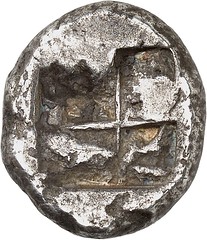
No. 143: Neapolis / Macedon. Stater, 525-450. From the Armand Trampitsch Collection, Vinchon auction (13 November 1986), No. 111. Rare, especially in this quality. Extremely fine. Estimate: 20,000 euros


No. 198: Axos / Crete. Stater, around 300 BC. From the Eckenheimer Collection, Roma Numismatics auction IX (2015), No. 262. Very rare. Very fine to extremely fine. Estimate: 10,000 euros


No. 306: Carthage / Zeugitania. Trihemistater in gold, around 260 BC. From Hess-Leu auction 7 (1957), No. 145. Rare. Extremely fine. Estimate: 30,000 euros
Coins from the Time of the Civil Wars
From a numismatic point of view, the most exciting period of Roman coinage was probably the civil wars that followed Caesar's death. This is not only because portraits established themselves as a typical coin motif during these years. Never before and never again has there been a time where coins were minted by so many different mints with so many different political messages. The coins of this period give us an insight into day-to-day politics during the last phase of the Roman Republic, with its short-lived alliances that quickly fell apart.
If you are interested in this era, Künker's catalog 419 is a must-read as it contains a wealth of iconic issues. There are, of course, several portraits of Caesar, but also the famous Eid Mar denarius, which comes from a collection completed before 1990. From the same collection are aurei that combine the portraits of various players, for example Marcus Antonius with Octavian or his sister Octavia. In addition to the Eid Mar denarius, the highlight of this small series is an aureus from a Syrian or Armenian mint showing Marcus Antonius presenting his son and presumed successor, Antonius Antyllus. Antyllus, who had been betrothed to Octavian's two-year-old daughter Julia at the age of 10, was only 13 years old at the time of the issue. After the suicide of his father and Cleopatra, he fled to the temple of Divus Iulius to seek asylum. But the "peace emperor" Augustus had no mercy: Antyllus, the son of Marcus Antonius and Fulvia, was executed along with 17-year-old Caesarion, the son of Caesar and Cleopatra.


No. 334: Caesar. Denarius, 44 BC, Rome, L. Buca. From the collection of a lawyer. From Helbing auction (9 April 1914), No. 955. Very rare. Very fine. Estimate: 2,500 euros


No. 337: M. Iunius Brutus. Denarius, 42 BC, military mint in Asia Minor or Northern Greece, L. Plaetorius Cestianus. From a collection completed before 1990. Very rare. Fine to very fine. Estimate: 50,000 euros
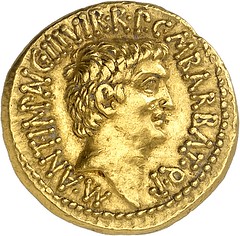

No. 342: Marcus Antonius / Octavianus. Aureus, 41 BC, Ephesus, M. Barbatius. From a collection completed before 1990. Very rare. Very fine + / very fine. Estimate: 12,500 euros


No. 344: Marcus Antonius / Octavia. Aureus, 38 BC, Athens(?). From a collection completed before 1990. Extremely rare. Very fine. Estimate: 15,000 euros


No. 346: Marcus Antonius / Antyllus. Aureus, 34 BC, Syrian or Armenian mint. From Münzen und Medaillen AG auction 25 (1962), No. 586. Extremely rare. Very fine. Estimate: 30,000 euros
Gold, Silver, Bronze: The Colorful World of Roman Coinage
No matter whether you love Roman aurei, prefer the magnificent portraits of Roman denarii, are desperate for a medallion or want to enjoy beautiful patinas: Künker's auction 419 has something for every taste. Of course, there are plenty of rare emperors and historically relevant reverses. The many excellent provenances, meticulously noted by the "lawyer", make many coins highly sought-after, rare and exclusive collectibles that are also popular with investors. It will be interesting to see what results individual pieces will fetch.


No. 410: Vitellius, 69. Denarius. From NGSA auction 16 (2022), No. 61. Extremely fine / About extremely fine. Estimate: 4,000 euros


No. 411: Vitellius, 69. Sestertius. From the collection of a lawyer; from the Dr. Etienne Paul Nicolas Collection, Kampmann auction (9/10 March 1982), No. 242. Rare. Very fine to extremely fine. Estimate: 5,000 euros


No. 414: Vespasian, 69-79. Sestertius, 71. From the collection of a lawyer; from the Apostolo Zeno Collection Part I, Dorotheum auction 975 (1955), No. 359. Rare. Very fine + / very fine. Estimate: 2,000 euros


No. 443: Hadrian, 117-138. Aureus, 130-132. From the collection of a lawyer; from the Gustave de Ponton d'Amécourt Collection, Rollin & Feuardent auction (25 April 1887), No. 240 (described as FDC); from the Montagu Collection, Rollin & Feuardent auction (20 April 1896), No. 295 (described as FDC). FDC. Estimate: 15,000 euros


No. 493: Commodus, 177-192. Aureus, 191-192. From a collection completed before 1990. Extremely rare. Estimate: 40,000 euros


No. 497: Pescennius Niger, 193-194. Aureus, unknown, perhaps moving mint. From a collection completed before 1990. Extremely rare. Traces of mounting, otherwise extremely fine / Very fine +. Estimate: 75,000 euros


No. 507: Caracalla, 198-217. Sestertius with hammered edge turning it into a protocontorniate, 213. Rev. Circus Maximus. From the collection of a lawyer. From Sotheby (8/9 October 1992), No. 1066. With old collector's card. Very rare. Very fine. Estimate: 5,000 euros
Protocontorniates are sestertii that were removed from normal circulation by hammering on the edge of the coin. At the time when Christianity was gaining ground, they were mainly used in Old Believer circles as a New Year's gift while being associated with traditional Roman values. Depictions of Circus Maximus were particularly popular for this purpose. In fact, the Circus Maximus and the chariot race were later adopted as a regular motif for the production of contorniates.


No. 526: Daldis / Lydia. Gordianus III, 238-244. AE medallion. From Giessener Münzhandlung auction 265 (2019), No. 1008. Very rare. Very fine +. Estimate: 15,000 euros


No. 535: Postumus, 260-268. Aureus, 266, Cologne. From the Vicomte E. de Quelen Collection, Rollin & Feuardent auction (14-26 May 1888), No. 1750; from the Montagu Collection, Rollin & Feuardent auction (20-26 April 1896), No. 656; from the collection of the Metropolitan Museum of Art, Sotheby auction (10 November 1972), No. 188. Very rare. About extremely fine. Estimate: 30,000 euros


No. 554: Constantinus I, 306-337. Medallion of 1 1/2 solidi, 326, Antioch. From a collection completed before 1990. Extremely rare. About extremely fine / Very fine +. Estimate: 25,000 euros


No. 555: Constantinus I, 306-337. Medallion of 1 1/2 solidi, 330-331, Thessalonica. From Bank Leu auction 20 (1978), No. 397. Probably unique. About extremely fine. Estimate: 20,000 euros
To order a catalog contact Künker, Nobbenburger Straße 4a, 49076 Osnabrück; phone: +49 541 / 962020; fax: +49 541 / 9620222; or via e-mail: service@kuenker.de. You can access the auction catalogs online at www.kuenker.de. If you want to submit your bid from your computer at home, please remember to register for this service in good time.
ANCIENT ROMAN COIN STUCK BETWEEN ROCKS
People exploring a cave in Spain discovered an ancient coin stuck between rock formations. -Editor
Deep inside a partially flooded cave of eastern Spain, scientists studied the walls by flashlight. Some markings and a coin jammed between rock formations caught their attention — and for good reason.
The traces revealed the chamber was once an ancient Roman sanctuary.
A joint team of researchers from the University of Alicante and the University of Zaragoza ventured into the Cova de les Dones as part of an ongoing project, the universities said in Jan. 30 news releases. The cave had been known since the 1960s for its prehistoric artwork but had not been studied in depth until recently.
About 650 feet into the cave, researchers entered a partially flooded chamber. A photo shows the illuminated cavern, which looks relatively generic.
But, when the team looked closer at the ceiling, they noticed an ancient Roman coin tucked between some rock formations, the university said.
Researchers also found at least 15 Roman inscriptions on the cave's walls. They didn't provide translations, but one photo shows the faded and easily overlooked writing.
Based on these finds, the team identified the chamber as the site of an ancient Roman sanctuary used for ritual purposes about 1,900 years ago, the university said. Researchers described it as a surprising and novel finding because traces of Roman activity at the site were previously considered scarce.
To read the complete article, see:
Cavers spot coin stuck between rock formations — and find ancient Roman site in Spain
(https://www.miamiherald.com/news/nation-world/world/article299643309.html)
HOLEY DOLLAR RETURNED TO POLAND
Here's the story of a well-traveled Holey Dollar, from Australia to Poland to Europe to Australia again and finally back to Poland. -Editor
A rare silver coin has been returned to Republic of Poland representative, Deputy Minister, Marta Cienkowska at a ceremony in Canberra.
Dating back more than 200 years, the coin was bought lawfully by a collector in the early 20th century and donated to a museum in Torun where it became a protected object of Poland.
It was stolen from the museum's collection between 2011 and 2016, sold in two auctions in Europe, and then made its way to Australia through unlawful export.
Acting on advice from the Office for the Arts and a restitution request from the Republic of Poland, the coin was seized by the Australian Federal Police under the Protection of Movable Cultural Heritage Act 1986 in August 2024, enabling its return.
The 1813 Holey Dollar is an example of coins used in the colony of New South Wales to address a currency shortage.
Originally a Charles III Spanish Silver Dollar minted in Mexico in 1777, it was one of 40,000 Spanish reales imported by Governor Lachlan Macquarie. The centre was cut out to create two new coins and the outer ring became known as the ‘Holey Dollar'.
Here are the coin photos rotated for easier reading of the overstamped inscriptions: "NEW SOUTH WALES 1813" and "FIVE SHILLINGS". -Editor
To read the complete articles, see:
Holey Dollar returned to Polish Government
(https://minister.infrastructure.gov.au/burke/media-release/holey-dollar-returned-polish-government)
Holey Dollar returned to Poland
(https://www.arts.gov.au/news/holey-dollar-returned-poland)
PRIVY MARKS ON COINS
Jeff Garrett posted a nice article about privy marks on the NGC website. Here's an excerpt - see the complete article online. -Editor
A privy mark is a small, distinguishing symbol or mark added to coins during the minting process, typically used to commemorate a special event, anniversary or to add a layer of security. The use of privy marks has a long history that dates to at least the 14th century. Early use of privy marks was to distinguish coins made at different times or to identify a different moneyer.
The added symbols were also utilized as a tool against counterfeiting. These marks can vary in design and are often placed in a discrete part of the coin, such as next to the date or mintmark.
The origin of the term privy marks is an old French word "prive," which was derived from the Latin word "privatus" meaning set apart or private. A privy mark is very different from a mintmark, which denotes the location of a coin's minting. The use of privy marks is not a new innovation from the US Mint.
A few great examples are from more than 100 years ago, with the 1922 Grant commemorative Half Dollars and Gold Dollars. To increase sales, the US Mint struck coins with a star symbol (?) on the obverse. The 1921 Alabama and Missouri Half Dollars were stuck with the addition of 2X2 and 2X4 stamps in the field, respectively. This was also done as a way to increase sales of these commemorative coins.
Historically, privy marks were used as identifiers of different mints or to track the journey of coins through various stages of production. In modern coinage, however, they are more commonly associated with commemorative or limited-edition coins.
For example, in 2020, the US Mint introduced a special privy mark on certain American Silver Eagle coins to celebrate the 75th anniversary of the end of World War II. The V75 symbol was also used for a very limited (1,939 struck) edition of the American Gold Eagles in Proof. These have been wildly popular and sell for nearly $20,000 today.
Privy marks serve as a way for collectors to differentiate between versions of the same coin, but they can also enhance the value of the coin, particularly if the minting run was limited or the design has historical significance. In most cases, the inclusion of a privy mark lends itself to lower mintages, making a coin more desirable among collectors.
To increase awareness and to stimulate collecting, the US Mint struck only 2 million National Parks Quarters commemorating five different parks with the V75 privy mark. This is only a tiny percentage of the more than one billion quarters struck that year. Despite looking carefully, I still have not found one in circulation. The coins are certainly out there to be "cherry-picked."
To read the complete article, see:
Jeff Garrett: Privy Marks on Coins
(https://www.ngccoin.com/news/article/13575/)
THE 2025 TRIAL OF THE PYX
It's that time of the year again - The Trial of the Pyx took place this week in London. Here's an Associated Press account. -Editor
Judges in red robes and white gloves convened Tuesday in the ornate livery hall of London's Worshipful Company of Goldsmiths for an ancient tradition dating back to the 12th century to certify Britain's coinage for circulation.
The test, known as the Trial of the Pyx, was designed to prevent counterfeiting by inspecting and weighing a sampling of thousands of coins from The Royal Mint to ensure they met the strictest standards.
"It's a way of making sure that if you're in the U.K. the coins that are in your pocket are real and reliable, that you know what they're made of, that they are up to the right standards," said Eleni Bide, the librarian for the Goldsmiths' Company. "That provides a challenge for people who want to fake them. So making really standardized perfect coins is a really important part of preventing forgery."
The mint submitted nearly 6,500 coins for testing that included future pocket change alongside gold bullion coins and limited edition collectibles in a variety of metals and finishes, including Harry Potter and Star Wars collections. In the past year, the mint has produced coins honoring Beatle Paul McCartney, the late musician George Michael and the writer George Orwell.
It also included a sixpence made from silver recycled from expired medical and industrial X-ray films.
The ceremony gets its name from the ancient Greek word "pyxis," or small box. Coins are presented in so-called Pyx boxes and jurors randomly select them for testing.
While the judges still used magnifying glasses to inspect the silver and gold pieces, the real testing takes place over months in labs.
The jury will deliver its verdict in May to the nation's treasury chief, who also serves as master of the mint and is responsible for the quality of the coins.
To read the complete article, see:
Nearly 800 Years of Pomp and Circumstance Ensures the Quality of Britain's Currency
(https://www.thenationalherald.com/nearly-800-years-of-pomp-and-circumstance-ensures-the-quality-of-britains-currency/)
See also:
UK coins tested for quality in the ‘Trial of the Pyx' ceremony
(https://apnews.com/video/uk-coins-tested-for-quality-in-the-trial-of-the-pyx-ceremony-6cd5f6d6c1b0446d968f9ec1e29faaab)
The Trial of the Pyx
(https://www.thegoldsmiths.co.uk/the-trial-of-the-pyx)
THE PENNY PURGE: COMMON CENTS OR CENTSLESS?
Of course, the big story in numismatics this week is President Trump's order to stop producing the U.S. one-cent piece or "penny". Our late friend and contributor Dick Johnson would be pleased, as he often wrote to promote that idea. Headline writers at least had fun riffing on the cents/sense homonym. Here's a smattering of articles and opinions.
Not being one to hang out on social media, the first reference I saw related to the Mint came in a January 6th Washington Post article about Trump donor and advisor Elon Musk. -Editor
"It is on X, not in some office or restaurant, that Republican politicians, tech industry executives and conservative influencers gather to post messages praising Musk's work, backing his stances and posting fodder for his arguments. The implicit hope is that Musk will reply or repost them approvingly to the platform's largest audience — and now that he's setting priorities for the Trump administration, perhaps even act on them.
On Sunday, Ryan Petersen, CEO of the San Francisco-based logistics firm Flexport, reached Musk directly with an X post that began, "Dear @DOGE please look into the U.S. Mint in San Francisco," suggesting it should be shut down and repurposed. An hour later, at 4:18 a.m. Eastern time, Musk replied, "Noted," ..."
To read the complete article, see:
Elon Musk is making X into his own digital Mar-a-Lago
(https://www.washingtonpost.com/technology/2025/02/06/musk-x-doge-influence/)
While many were watching a lopsided Super Bowl game the evening of Sunday the 10th, Trump was readying an announcement, likely choosing the moment for maximum exposure (or ability to divert attention from other things). The Washington Post and New York Times covered the topic well. -Editor
 "President Donald Trump says he has ordered the U.S. Treasury to stop minting pennies, calling their production "wasteful."
"President Donald Trump says he has ordered the U.S. Treasury to stop minting pennies, calling their production "wasteful."
"For far too long the United States has minted pennies which literally cost us more than 2 cents," Trump said in a Truth Social post Sunday night. "Let's rip the waste out of our great nations budget, even if it's a penny at a time."
"No other official announcement on penny production has been made, and Treasury did not immediately respond to an overnight request for comment. It was not immediately clear whether the president has the unilateral power to take a coin out of circulation; Congress oversees the production of coins and operations of the U.S. Mint, which falls under the Treasury Department, according to the agency.
"The debate over whether to continue making lower-denomination coins has gone on for years, particularly as costs to produce them have steadily risen."
It's a well-written article despite its use of the incorrect term "penny". As noted in the past, I've gotten over being a scold on that losing-battle issue. While correctly referencing the U.S. Mint website, the reporters do slip up by misinterpreting the first year of the cent's production (it was 1793, not 1792) -Editor
To read the complete articles, see:
Trump says he ordered Treasury Department to stop producing new pennies
(https://www.washingtonpost.com/nation/2025/02/10/trump-us-mint-penny-coins/)
Trump Orders Treasury Secretary to Stop Minting Pennies
(https://www.nytimes.com/2025/02/09/us/politics/trump-stop-minting-pennies.html)
A Washington Post Opinion piece the same day took a more detailed look at the composition and cost of U.S. coins. -Editor
"The U.S. Mint, as it turns out, has a lot of interesting information about the historical production of coins. I learned Monday morning that we used to make a 3-cent piece, as well as a $20 coin. Both of those might be fun to revive.
"Coin production faces the same problem as everything else: inflation. Pennies, as you probably know, aren't really made out of copper but, instead, mostly zinc. Nickels, dimes and quarters, weirdly, are mostly copper. The U.S. Mint also has a nice chart on the composition of coins over time.
"Pennies have cost more to make than they have been worth for some time now. Pennies cost more than a penny to make as of 2006; nickels cost more than a nickel to make that same year. Over the following 18 years, the cost of making a penny has surged to about 3.7 pennies, while the cost of making a nickel is now about 2.8 nickels.
"So why target pennies instead of nickels? Because the Mint makes far more pennies. In 2024, the Mint shipped nearly 3.2 billion pennies. It shipped only 202 million nickels. The net loss from producing pennies was about five times the net loss from producing nickels.
"We must note that, as with so many of Trump's other second-term pronouncements, permanently ending production of pennies would require Congress to act. We will see whether the Republican-controlled House and Senate take up this issue, or whether Big Zinc once again throws its weight around the halls of the Capitol."
To read the complete article, see:
Making pennies is a money-loser. Making nickels is worse.
(https://www.washingtonpost.com/opinions/2025/02/10/trump-us-mint-pennies-nickels-production/)
Jeff Rock wrote:
"There are options to keep the denomination, including plastic or fiber of some sort - but it's not particularly useful in commerce these days. Who even bothers to bend over to pick up a cent on the ground these days? I've seen homeless people toss cents from the cups they get change in! But still...tradition!
"As for politics, the Republicans haven't wanted to get rid of it because it has Lincoln on it, the first Republican (though he would not be one today after the parties changed their base during the Civil Rights Movement). Democrats haven't wanted to get rid of it because they didn't want to be attacked for getting rid of Lincoln, but letting FDR stay on a coin (Kennedy too, though halves are almost non-existent now). So while it would have made economic sense to get rid of it, it was very, very slight economic sense at best. The mint makes money on every other denomination and could easily absorb a loss on the cent (which should have gone to plastic or fiber long ago, or been greatly reduced in size as was the case for the 1-cent euro pieces), but copper and zinc lobbies are strong..."
Ah, the lobbyists. You knew it wouldn't be long before we started hearing from them. This CNN Business article cites one argument. Bloomberg also repeated some lobbyist talking points, -Editor
 "For far too long the United States has minted pennies which literally cost us more than 2 cents. This is so wasteful!" he said in a post on his Truth Social platform. "Let's rip the waste out of our great nations budget, even if it's a penny at a time."
"For far too long the United States has minted pennies which literally cost us more than 2 cents. This is so wasteful!" he said in a post on his Truth Social platform. "Let's rip the waste out of our great nations budget, even if it's a penny at a time."
"Trump actually undersold the cost argument — pennies cost more than 3 cents to produce.
"But there's a problem with his plan: Phasing out the penny could result in needing to make more nickels, and the US Treasury Department loses far more money on every nickel than it does on every penny.
"Without the penny, the volume of nickels in circulation would have to rise to fill the gap in small-value transactions. Far from saving money, eliminating the penny shifts and amplifies the financial burden," said American for Common Cents, a pro-penny group funded primarily by Artazn, the company that has the contract to provide the blanks used to make pennies.
Lobbyists love to use math, but only selectively. 3.7 cents apiece on nearly 3.2 billion pennies would save $118.4 million. Just how many more five-cent pieces would be needed to fill the gap? Today we make 220 million/year. At 14 cents apiece they cost $30.8 million. Even if nickel production would triple there would still be savings to be had.
All of this speculation is moot of course, because Congress makes the final decision, and there will be plenty of proposals and lobbying between now and then, and plenty of time for the decision to stop making cents to begin affecting everyday commerce.
I've not seen any effects with my own spending. I still make several cash transactions a week, and still give and take cents. Maybe there are so many non-cash transactions that no one will care or notice. Are readers seeing any effects yet?
As an Executive Order the directive lacks permanence, and could be overturned by the next President at the stroke of another pen, as we've already seen with the see-saw changes in control of the White House over recent elections - kind of an idiotic slow-motion face-slapping contest. "Your EOs are stupid!" "No, YOUR EOs are stupid!!" -Editor
To read the complete articles, see:
Getting rid of the penny introduces a new problem: nickels
(https://www.cnn.com/2025/02/10/business/costs-of-pennies-and-nickels/index.html)
Trump Plan to Ditch the Penny Comes With Twist: It May Not Save Much
(https://www.bloomberg.com/news/articles/2025-02-10/trump-plan-to-kill-penny-comes-with-twist-it-may-not-save-much)
Some outlets focused on impact to collectors. -Editor
"How could that trickle down to local coin and penny collectors? The penny, often lost in pockets and couch cushions, is the centerpiece for some. The obvious answer is that a halt in production would increase value, but a local coin collector and antique store owner says it may not be that simple.
"There are billions of pennies in circulation, and until now, more every year. This leaves penny collections oversaturated. With the pause in production, Simmons sees the phasing out of the penny as a natural progression.
"We don't produce $2 bills anymore. We don't produce, you know, gold coins anymore," he said.
"As for their potential increase in value, Simmons says new pennies are never more valuable than their assigned worth.
"It's just another spot to fill in a book. There's lots of things to collect and lots of books to fill without worrying about a 2026 or 2027 coin not being there," he said.
"It could take generations for — sometimes decades old — pennies to gain substantial value. Regardless, the scarcity tends to generate interest."
Well said. But the Mint could lobby for a carve-out for collectible cents that would earn the government far more than their cost. Continued annual proof and mint set inclusion are one obvious option, but the alternatives are endless. -Editor
To read the complete article, see:
How could the halt on pennies affect collectors?
(https://www.ksn.com/news/local/penny-production-halted-how-could-it-affect-local-coin-collectors/amp/)
"Rare coin and precious metal collector Jonathan Aminov told CBS News he doesn't predict a huge jump in price for the penny.
"I get calls about pennies all day long," said Aminov, who owns Big Apple Coins in Manhattan.
"He said the U.S. won't see a foreseeable shortage of pennies anytime because there are too many coins in circulation.
"Aminov said collectors might see interest in the 2025 penny because that was the year the coin stopped being minted. If 500 million pennies were ordered for the year and 50 million were minted, then those coins are going to be more desirable, he said.
"He also cautioned that it would be difficult to obtain big prices for pennies as the coin would have to be extremely rare saying, "Pennies are a bit of a longshot."
"However, the end of penny production can bring new interest and collectors into a hobby that Aminov says could be a good thing. And once someone is hooked on coin collecting it's hard to get out, he says.
"It's easy to fall in love with coins," said Aminov. "And the people who love it really, really love it. They spend obscene amounts of money to purchase their coin and then stare at it for hours in love with its beauty and history."
I would agree that the publicity around this idea and the eventual retreat of cents from circulation will likely lead to further interest in collecting from the general public. Always has, always will. Collecting in the U.S. got its biggest boosts from the demise of the large cent in 1858 and the retreat from silver in the mid-1960s. -Editor
To read the complete article, see:
Trump's plan to scrap the penny spikes interest for coin collectors
(https://www.cbsnews.com/news/trump-penny-interest-coin-collections/)
The Mints aren't going anywhere, not the main ones, anyway. The Denver Gazette seized the moment to tour the Denver Mint. -Editor
"A group of 30 tourists stood in the foyer of the Denver Mint on Tuesday afternoon, surrounded by the sparkling marble sourced from Vermont when the building was built in 1904.
"An American eagle and flag stood above them on the flecked wall, engraved with gold and platinum — a monument to the importance the Denver historical building has had on the country for more than a century.
"Just a few yards away, 54 coin pressers, multiple sorters and pick-and-place robots buzzed away, continuously stamping circular materials to make the coins the United States Federal Reserve Bank then uses for circulation.
"Even if the penny was scratched from the future currency inventory, the mint will continue its longstanding history of pressing coins and giving out hour-long tours to golden-eyed visitors."
To read the complete article, see:
Denver Mint presses on despite potential penny pause
(https://denvergazette.com/news/local/denver-mint-history-and-tour/article_fb8fff5c-e8c0-11ef-ab86-2713b452d78f.html)
Here's a short article summarizing what happened when other countries got rid of their smallest coins. -Editor
Canada
When Canada got rid of its penny in 2012, it allowed the coins to remain in circulation and legal tender but encouraged merchants to round monetary amounts to the nearest 5-cent increment and implemented a consumer education program so shoppers would become accustomed to the idea. Today, the practice of rounding up or down to the nearest 5-cent increment when paying with cash has become as ordinary to Canadians as being a fan of ice hockey.
New Zealand
New Zealand eliminated 1- and 2-cent coins in 1990, and then took things a step further in 2006 with the elimination of its 5-cent coin. Researchers found that prices actually went down instead of up. One government official suggested that market competition was enough to keep retailers from trying to game the system.
To read the complete article, see:
Small Change: What Happened When Other Countries Got Rid of Their Pennies
(https://money.com/get-rid-of-pennies/)
This Washington Post Opinion piece waxes nostalgic: "Although its face value is close to zero, the penny is priceless as a bit of Americana." -Editor
"But if this is the beginning of the end for the penny, let us fondly, if fleetingly, salute the less-than-majestic but nevertheless swell part it has played in the country's life. A penny could never buy you much, but it could buy you something: It was no coincidence that drugstores placed penny-a-crank gum-ball machines near their front doors, knowing that the colorful sight would extract the departing customers' last cents. Penny arcades promised pleasure on a budget. The penny loafer, with the slits on each shoe for the coin, went from utilitarian to sublime because of it.
"The penny was a synonym for value, shorthand for what-can-you-lose sales pitches: the sound of "one red cent" from the mouths of carnival barkers lured you to the tent, even as you sensed you were about to fork over more than that. Merchandisers set their price points at $5.99 or $24.99 because they knew the missing final penny would do the heavy lifting for them by making the item feel less expensive than it was."
To read the complete article, see:
Trump Stops Making Cents
(https://www.wsj.com/opinion/trump-stops-making-cents-pennies-coins-history-1cdcb9b9)
Wayne Pearson writes:
"Currently, there are bills in the Senate and the House, S.1228 - Coin Metal Modification Authorization and Cost Savings Act of 2023, and H.R.2817 to SAVE money in the making of our nickel, dime and quarter.
"Leader Thune and Speaker Johnson need to take this seriously.
"We lost $85.3 million in 1¢ coins and $17.7 million in 5¢ coins, last year, HOWEVER . . . through Seigniorage, we made sufficient seigniorage from dimes, quarters, half dollars, and dollar coins, to offset any losses.
"Additionally, the seigniorage made on all paper money is overwhelming.
"According to the Federal Reserve's website, it costs 3.2¢ to make a dollar bill, so we are making a 97¢ profit on each one produced.
"For every one hundred dollar bill produced at 9.4¢, we make a whopping $99.90 cent profit.
"So even with some losses on the smaller coins, those losses do not come close to comparing with the profits we are making through seigniorage."
To read the complete Federal Reserve webpage, see:
How much does it cost to produce currency and coin?
(https://www.federalreserve.gov/faqs/currency_12771.htm)
Thanks, everyone. Thanks also to Leon Saryan, Howard Berlin, Andrew Pollock for passing along additional articles on the topic. -Editor
See:
Trump Directs Treasury Secretary Scott Bessent to ‘Stop Producing New Pennies'
(https://www.breitbart.com/politics/2025/02/09/trump-directs-treasury-secretary-scott-bessent-stop-producing-new-pennies/)
Trump directs Treasury to stop minting new pennies, citing cost
(https://www.cbsnews.com/news/trump-directs-treasury-to-stop-minting-new-pennies-citing-cost/)
BULK COIN MELT-VALUE SPECULATION
And right behind the lobbyists are the metal speculators and suppliers who cater to them. This Bloomberg article looks at bulk coin melt-value speculation. -Editor
Adam Youngs is looking to make a lot from truckloads of the little red cent.
His company, Portland Mint, sells old pennies in bulk — 40,000 pounds (18,100 kilograms) at a time — to investors angling to profit on the copper that makes up 95% of the coins minted before 1983. A cache of one-cent pieces from Portland Mint with a face value of roughly $60,000 sells for about $120,000.
The wager is that those older pennies contain copper that would be worth about $180,000 at current prices. One snag: It's illegal to melt a mass of Lincoln cents to harvest the metal. But penny hoarders gained fresh hope that their bets will one day pay off when President Donald Trump said this week that he ordered the Treasury secretary to stop minting the coins.
Perhaps the demise of the humble penny, the thinking goes, will eventually bring an end to the melting ban – positioning owners of the coins to cash in on their mountains of cheap copper.
"You buy at a discount now, things change in the future, then you can actually capture the true value," Youngs said.
"Collectors and investors speculate the value of copper will go up," said Ted Ancher, director of numismatics at Apmex, a precious metals dealer in Oklahoma City that has been selling copper pennies for years. "That is the primary reason they buy copper cents."
Customers favor "the '82 and earlier stuff," said Dennis Steinmetz, founder of Steinmetz Coins & Currency in Lancaster, Pennsylvania. The company offers 5,000 pennies – with a $50 face value – for $79.
"As you may know you may not currently melt these," Steinmetz's website says. "However if the government authorizes melting you will be way ahead."
Modern pennies, composed of copper-plated zinc, contain little melt value. So the game for investors is to find the older, mostly copper pieces.
At his warehouse in Oregon, Youngs isolates the more valuable older pennies with 15 industrial sorting machines that can sift through 3,000 coins a minute. Do-it-yourselfers can opt for semi-automatic sorter made by Michigan's Ryedale Enterprises that can work through as many as 300 cents a minute.
Or penny hunters can just buy old coins.
"We've seen a major uptick in the last few weeks with copper prices making headlines and rising again," said Stefan Gleason, chief executive officer of Money Metals Exchange. The firm sells 34-pound bags of copper pennies for $203.66, or about 4 cents a coin.
To read the complete article, see:
Trump Penny-Killing Plan Stirs Hope of Profit, 20 Tons at a Time
(https://www.bloomberg.com/news/articles/2025-02-14/penny-hunters-eye-profit-from-trump-coin-attack-with-melting-bet)
COLONIAL GEORGIA COLORED SEALS, PART 2
Bob Rhue's exhibit of "The Colored Seal Notes of Colonial Georgia" won the American Numismatic Association's Howland Wood Memorial Award for Best-of-Show exhibit in 2017. His exhibit was photographed and memorialized on the ANA website. This series of articles dives into each of the seven exhibit cases with high-resolution images of each note. To the casual observer the notes look similar, but a closer look reveals a multitude of interesting detail.
This week we dive into the contents of Case 2 of 7. -Editor
To read the complete exhibit pages, see:
The Colored Seal Notes of Colonial Georgia
(https://www.money.org/howlandwood2017/)
To read the earlier E-Sylum articles, see:
Colonial Georgia Colored Seals, Part 1
(https://www.coinbooks.org/v28/esylum_v28n06a25.html)
ASCENDING AND DESCENDING PAIRS
Collectors of paper money often gravitate to notes with notable serial numbers, such as very low numbers, solid numbers of all the same digit, and "radar" numbers that read the same backwards as forwards. This PMG article discusses a pattern I hadn't heard of. Found via News & Notes from the Society of Paper Money Collectors (Volume X, Number 34, February 4, 2025). -Editor
For some collectors, these fun sequences of numbers on a banknote are a step above ordinary notes.
An Ascending Pairs Serial Number is one where the first two digits are the same number and then each subsequent pair of numbers is one digit higher. For instance, the Culver City, California 1929 $5 National Bank Note below has an Ascending Pairs Serial Number of B001122A. (This PMG-certified note is part of a Heritage Auctions sale in February 2025.)
Descending Pairs Serial Numbers follow the same pattern except the digits grow smaller. This 2017A $1 Federal Reserve Note has a Descending Pairs Serial Number of K88776655A. (This note realized $150 in a Heritage Auctions sale in June 2021.)
Collectors and dealers with fancy serial numbers can submit them to PMG for certification and attribution under an applicable grading tier. All fancy serial number banknotes must be submitted on a separate submission form. There is no additional fee for this service.
To read the complete article, see:
The Fancy Serial Number Files: Ascending Pairs and Descending Pairs
(https://www.pmgnotes.com/news/article/13704/fancy-serial-numbers-ascending-descending-pairs/)
NUMISMATIC ART IN NEW YORK
An installment of Steve Roach & Dennis Tucker's "Collecting Friends" blog series highlights some interesting numismatic art in Mexico, NY and New York City. Here's an excerpt - see the complete article online.
First, Dennis Tucker relates a visit to Mexico, New York. -Editor
... I want to focus on a huge surprise that awaited me in Mexico—specifically, a huge COIN! When we pulled into the parking lot across from the museum, the last thing I expected to see was a gigantic silver half dollar. And yet, there it was, in mural form, on the side of the Town Hall building.
 It was a Walking Liberty half dollar, dated 2004 (the year it was painted by Syracuse artist Kenneth C. Burke), and it's part of a mural called "Mexico—Path to Freedom."
It was a Walking Liberty half dollar, dated 2004 (the year it was painted by Syracuse artist Kenneth C. Burke), and it's part of a mural called "Mexico—Path to Freedom."
This northeastern New York town was very important in the passage of slaves to freedom through the Underground Railroad in the early 1800s. In a plaque accompanying the mural, the Walking Liberty half dollar is identified as symbolic of the "financial support of freedom" offered by Mexico's businessmen.
A numismatist might ask, "Why not show a Liberty Seated half dollar, the type minted from the 1830s to the 1890s?" That's what would have been in circulation during the Underground Railroad era, when abolitionists like Mexico tinsmith Starr Clark risked their businesses (and their own safety) to support others' freedom.
The town's connection to the Walking Liberty half dollar was explained to me by Mexico Historical Society volunteer Jim Hotchkiss. "Audrey Munson, the artist's inspiration for Miss Liberty on the half dollar, lived in Mexico before she became America's most famous model, and again after her career crashed," Jim told me. He's assembled a collection of Munsonabilia that includes postcards, magazine articles, sculptures, and other mementoes.
Numismatists know many of the artists she posed for. They included coin and medal designers like Robert Aitken, John Flanagan, Daniel Chester French, and Adolph A. Weinman.
Then, Steve Roach chimes in with a New York City sculpture I was unfamiliar with. -Editor
I found one of my favorite pieces of art incorporating coins while exploring downtown New York City a few years ago. Margie Hughto's 1997 work titled Trade, Treasure and Travel is at the Cortlandt Street station of the R and W trains. It consists of various ceramic relief tiles that were re-installed in 2011 in the new underpass connecting the Cortlandt station with the nearby Fulton Center, after the destruction of the World Trade Center a decade earlier.
 The artist said that she thought about the history of the financial district, when Cortlandt street ended at a busy ferry landing on the Hudson River. She shared, "I thought about the different peoples, products, objects and money that passed through the area, and I visualized a treasure vault filled with coins, gems and artifacts – rich, golden, glowing and somewhat mysterious." Renditions of Peace dollars, Standing Liberty quarter dollars, Kennedy half dollars, Indian Head cents and Indian Head 5-cent pieces are seen, alongside fanciful interpretations of $1 Federal Reserve Notes and plenty of other coins both real and imagined.
The artist said that she thought about the history of the financial district, when Cortlandt street ended at a busy ferry landing on the Hudson River. She shared, "I thought about the different peoples, products, objects and money that passed through the area, and I visualized a treasure vault filled with coins, gems and artifacts – rich, golden, glowing and somewhat mysterious." Renditions of Peace dollars, Standing Liberty quarter dollars, Kennedy half dollars, Indian Head cents and Indian Head 5-cent pieces are seen, alongside fanciful interpretations of $1 Federal Reserve Notes and plenty of other coins both real and imagined.
The work consists of 11 separate, but thematically related panels made of ceramic tiles, with plenty of coins alongside compasses, boats, streetcars, keys, ships, and animals both real (bulls and bears) and imagined (griffins and a sphinx). The reliefs were made in the artist's Jamestown, New York, studio and students from the School of Art and Design at Syracuse University assisted. Every time I look at them, I always find something new to enjoy.
To read the complete article, see:
Collecting Friends: An American Silver Half Dollar in Mexico
(https://blog.money.org/coin-collecting/american-half-dollar-in-mexico)
THE COSTS OF COLLECTING
Gerry Tebben writes:
"Here's an interesting story in the Wall Street Journal about the costs and hazards of collecting. Beth Deisher is quoted at the end about the perils of counterfeits."
Thanks. Here's an excerpt. -Editor
 When investors talk about collecting, they typically revel in the ability to pursue their passions, have fun and possibly make a little (or maybe even a lot) of money. But there's another side to the collectibles story—and it involves time, vigilance and financial resources.
When investors talk about collecting, they typically revel in the ability to pursue their passions, have fun and possibly make a little (or maybe even a lot) of money. But there's another side to the collectibles story—and it involves time, vigilance and financial resources.
Yet for collectors who can withstand the lack of liquidity and take steps to preserve value, these can be good alternative investments that aren't correlated with more-traditional markets, says Robert Rosenthal, chairman and chief executive of First Long Island Investors, who collects art with his wife, Jodi Rosenthal.
Here's a closer look at some of those lesser-discussed issues:
The costs of care
Collectibles experts say some beginning collectors don't realize that certain collections need special care and storage for their objects to retain value.
Light and temperature fluctuations are notorious for causing damage to holdings. Paintings, for instance, may require special glass, while fragile items such as textiles and sneakers need temperature-controlled storage.
At-home safes can protect items such as baseball cards, rare coins and antique guns, but they need to be bolted down to prevent theft. What's more, if you choose a home safe to store your collection you should look for one that is fire-resistant.
"The care of each of those collections is very important to the ultimate value, and you can really compromise the value of these collectibles if not properly stored," Rosenthal says.
Inventory and insurance
Just as with traditional investments, collectors need to keep an inventory of holdings for insurance purposes and to track prices to avoid selling at lows or to maximize value.
Keeping good records such as sales receipts and appraisals matter to establish a cost basis. This can affect valuations and potential taxes if the person sells or bequeaths a collection, says Steve Lockshin, co-founder of Vanilla, an estate-planning software firm.
Fakes and frauds
Another pitfall that potential collectors need to be aware of: The collecting boom and ease of buying online has led to a similar boom in fakes in almost all collectible categories.
For example, as precious-metals prices rise, it has attracted new collectors who may not be on the lookout for counterfeit gold and silver coins, says Beth Deisher, executive director of the Anti-Counterfeiting Educational Foundation. Scammers not only create sophisticated websites to fool consumers into purchasing fakes, but new technology can also produce harder-to-detect fake coins.
To read the complete article (subscription required), see:
The Hidden Costs of Being a Collector
(https://www.wsj.com/finance/investing/collecting-pros-cons-investment-7fdca799)
ABOUT THIS ISSUE: FEBRUARY 16, 2025
 Recently I reported that my old friend Pat McBride of the Pennsylvania Association of Numismatists had been diagnosed with Acute Myeloid Leukemia on Christmas day. I also noted that he was under the care of the top specialist at Pittsburgh's top cancer center, and under the watchful eye of his wife Dawn, a nurse.
Recently I reported that my old friend Pat McBride of the Pennsylvania Association of Numismatists had been diagnosed with Acute Myeloid Leukemia on Christmas day. I also noted that he was under the care of the top specialist at Pittsburgh's top cancer center, and under the watchful eye of his wife Dawn, a nurse.
Well, miraculously, Pat seems to be in remission just three weeks later. The treatments are working. He still has a difficult road, but this a remarkable development. Perhaps his alter ego Dr. Franklin was watching over him as well. Good luck, and get better soon! -Editor
Wayne Homren
Wayne Homren is the founding editor of The E-Sylum and a consultant for the Newman Numismatic Portal. His collecting interests at various times included U.S. Encased Postage Stamps, merchant counterstamps, Pittsburgh Obsolete paper money, Civil War tokens and scrip, Carnegie Hero Medals, charge coins and numismatic literature. He also collects and has given presentations on the work of Money Artist J.S.G. Boggs. In the non-numismatic world he's worked in artificial intelligence, data science, and as a Program Manager for the U.S. Department of Defense.
Garrett Ziss
Garrett Ziss is a numismatic collector and researcher, with a focus on American paper money and early U.S. silver and copper coins. He is also a part-time U.S. coin cataloger for Heritage Auctions. Garrett assists Editor Wayne Homren by editing and formatting a selection of articles and images each week. When he's not engaged in numismatics, Garrett is a Senior Honors student at the University of Pittsburgh.
Pete Smith
Numismatic researcher and author Pete Smith of Minnesota has written about early American coppers, Vermont coinage, numismatic literature, tokens and medals, the history of the U.S. Mint and much more. Author of American Numismatic Biographies, he contributes original articles to The E-Sylum often highlighting interesting figures in American numismatic history.
Greg Bennick
Greg Bennick (www.gregbennick.com) is a keynote speaker and long time coin collector with a focus on major mint error coins and US counterstamps. He is on the board of both CONECA and TAMS and enjoys having in-depth conversations with prominent numismatists from all areas of the hobby. Have ideas for other interviewees? Contact him anytime on the web or via instagram
@minterrors.
John Nebel
Numismatist, photographer, and ANS Board member and Fellow John Nebel of Boulder, CO helped the ANA and other clubs like NBS get online in the early days of the internet, hosting websites gratis through his Computer Systems Design Co. To this day he hosts some 50 ANA member club sites along with our
coinbooks.org site, making the club and our E-Sylum archive available to collectors and researchers worldwide.
Bruce Perdue
Encased coinage collector (encasedcoins.info) Bruce Perdue of Aurora, Illinois has been the volunteer NBS webmaster from its early days and works each week to add the latest E-Sylum issue to our archive and send out the email announcement.
To read the earlier E-Sylum article, see:
ABOUT THIS ISSUE: JANUARY 26, 2025
(https://www.coinbooks.org/v28/esylum_v28n04a32.html)

